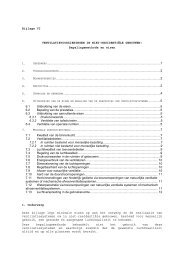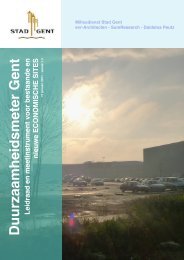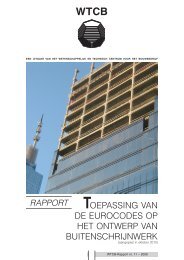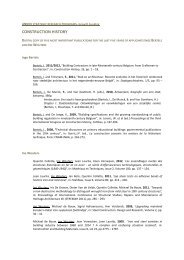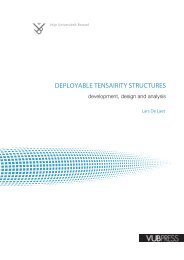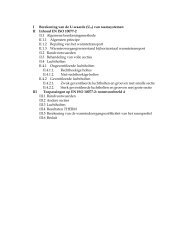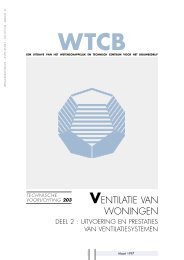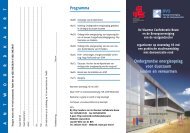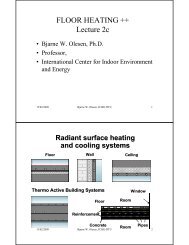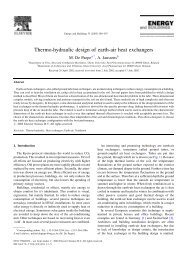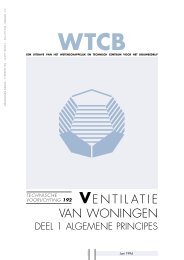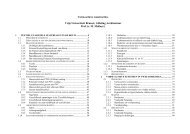Wind engineering in the integrated design of princess Elisabeth ...
Wind engineering in the integrated design of princess Elisabeth ...
Wind engineering in the integrated design of princess Elisabeth ...
Create successful ePaper yourself
Turn your PDF publications into a flip-book with our unique Google optimized e-Paper software.
<strong>W<strong>in</strong>d</strong> <strong>eng<strong>in</strong>eer<strong>in</strong>g</strong> <strong>in</strong> <strong>the</strong> <strong>in</strong>tegrated <strong>design</strong> <strong>of</strong> pr<strong>in</strong>cess <strong>Elisabeth</strong> Antarctic base<br />
Javier Sanz Rodrigo *, Jeroen van Beeck, Jean-Marie Buchl<strong>in</strong><br />
von Karman Institute for Fluid Dynamics (VKI), Chaussée de Waterloo 72, B-1640 Rhode-St-Genèse, Belgium<br />
article <strong>in</strong>fo<br />
Article history:<br />
Received 15 October 2011<br />
Received <strong>in</strong> revised form<br />
19 December 2011<br />
Accepted 29 December 2011<br />
Keywords:<br />
Antarctica<br />
Integrated <strong>design</strong><br />
<strong>W<strong>in</strong>d</strong> <strong>eng<strong>in</strong>eer<strong>in</strong>g</strong><br />
Snowdrift<br />
<strong>W<strong>in</strong>d</strong> load<strong>in</strong>g<br />
Sand erosion<br />
1. Introduction<br />
abstract<br />
The concern about Climate Change has significantly <strong>in</strong>creased<br />
<strong>the</strong> <strong>in</strong>terest <strong>of</strong> scientific research <strong>in</strong> Antarctica. Co<strong>in</strong>cid<strong>in</strong>g with <strong>the</strong><br />
International Polar Year (IPY) 2007e2008, three European research<br />
bases were <strong>design</strong>ed and have recently been deployed <strong>in</strong> Antarctica:<br />
Halley VI (United K<strong>in</strong>gdom), Newmayer III (Germany) and<br />
Pr<strong>in</strong>cess <strong>Elisabeth</strong> (Belgium).<br />
The new stations put <strong>in</strong> evidence <strong>the</strong> primary role that <strong>the</strong><br />
environmental conditions play on <strong>the</strong>ir <strong>design</strong>, especially when<br />
higher levels <strong>of</strong> susta<strong>in</strong>ability and energy efficiency are pursued, as<br />
it is <strong>the</strong> case for <strong>the</strong> Pr<strong>in</strong>cess <strong>Elisabeth</strong> “Zero Emission” research<br />
station.<br />
The <strong>in</strong>tegrated <strong>design</strong> process, implemented <strong>in</strong> <strong>the</strong> case <strong>of</strong> <strong>the</strong><br />
Pr<strong>in</strong>cess <strong>Elisabeth</strong> base, aims at mak<strong>in</strong>g best use <strong>of</strong> <strong>the</strong> ambient<br />
conditions <strong>in</strong> <strong>the</strong> <strong>design</strong> <strong>of</strong> energy efficient build<strong>in</strong>gs with <strong>the</strong> least<br />
impact on <strong>the</strong> environment throughout <strong>the</strong>ir lifetime. The use <strong>of</strong><br />
renewable energies <strong>in</strong> Antarctica as primary energy source<br />
provides more autonomy, m<strong>in</strong>imiz<strong>in</strong>g <strong>the</strong> fuel consumption with<br />
<strong>the</strong> correspond<strong>in</strong>g sav<strong>in</strong>gs <strong>in</strong> logistics, CO2 emissions and risks <strong>of</strong> oil<br />
spill contam<strong>in</strong>ation.<br />
* Correspond<strong>in</strong>g author. National Renewable Energy Centre <strong>of</strong> Spa<strong>in</strong> (CENER),<br />
C/Ciudad de la Innovación 7, 31621 Sarriguren, Spa<strong>in</strong>. Tel.: þ34 948 25 28 00;<br />
fax: þ34948270774.<br />
E-mail address: jsrodrigo@cener.com (J. Sanz Rodrigo).<br />
0360-1323/$ e see front matter Ó 2012 Elsevier Ltd. All rights reserved.<br />
doi:10.1016/j.buildenv.2011.12.023<br />
Build<strong>in</strong>g and Environment 52 (2012) 1e18<br />
Contents lists available at SciVerse ScienceDirect<br />
Build<strong>in</strong>g and Environment<br />
journal homepage: www.elsevier.com/locate/buildenv<br />
The Belgian Antarctic Base Pr<strong>in</strong>cess <strong>Elisabeth</strong> is based on an elevated build<strong>in</strong>g on top <strong>of</strong> slop<strong>in</strong>g terra<strong>in</strong><br />
and connected to an under-snow garage. The <strong>in</strong>tegrated <strong>design</strong> <strong>of</strong> <strong>the</strong> base was supported by w<strong>in</strong>d<br />
<strong>eng<strong>in</strong>eer<strong>in</strong>g</strong> test<strong>in</strong>g that looked <strong>in</strong>to build<strong>in</strong>g aerodynamics (pressure taps) and snowdrift management.<br />
<strong>W<strong>in</strong>d</strong> tunnel model<strong>in</strong>g us<strong>in</strong>g sand erosion technique allowed efficient evaluation <strong>of</strong> <strong>the</strong> snow erosion<br />
and deposition around different build<strong>in</strong>g-block shapes dur<strong>in</strong>g <strong>the</strong> conceptual <strong>design</strong> phase. Parametric<br />
test<strong>in</strong>g shows that <strong>the</strong> position<strong>in</strong>g <strong>of</strong> <strong>the</strong> ma<strong>in</strong> build<strong>in</strong>g on <strong>the</strong> ridge has a significant impact on w<strong>in</strong>d<br />
load<strong>in</strong>g and snow erosion and deposition. Important reductions <strong>in</strong> w<strong>in</strong>d load<strong>in</strong>g and snow deposition<br />
can be obta<strong>in</strong>ed by elevat<strong>in</strong>g <strong>the</strong> build<strong>in</strong>g and reduc<strong>in</strong>g <strong>the</strong> w<strong>in</strong>dward cantilever. The position<strong>in</strong>g <strong>of</strong> <strong>the</strong><br />
garage ro<strong>of</strong> can fur<strong>the</strong>r decrease <strong>the</strong> w<strong>in</strong>d load<strong>in</strong>g by act<strong>in</strong>g as a diffuser <strong>in</strong> <strong>the</strong> back <strong>of</strong> <strong>the</strong> build<strong>in</strong>g. This<br />
study shows that, not only for safety and cost reduction but also for <strong>the</strong> <strong>in</strong>tegration <strong>of</strong> renewable<br />
energies, important benefits <strong>in</strong> <strong>the</strong> <strong>design</strong> <strong>of</strong> a build<strong>in</strong>g can be achieved if w<strong>in</strong>d <strong>eng<strong>in</strong>eer<strong>in</strong>g</strong> is considered<br />
s<strong>in</strong>ce <strong>the</strong> conceptual phase <strong>of</strong> <strong>the</strong> <strong>in</strong>tegrated build<strong>in</strong>g <strong>design</strong> process.<br />
Ó 2012 Elsevier Ltd. All rights reserved.<br />
The extreme wea<strong>the</strong>r conditions make Antarctic construction<br />
<strong>the</strong> forefront <strong>of</strong> Bioclimatic Architecture, with katabatic w<strong>in</strong>ds up to<br />
70 m s 1 that <strong>in</strong>duce important structural load<strong>in</strong>g; snow drift<strong>in</strong>g<br />
that can produce annual build-ups as high as 1.5 m, mak<strong>in</strong>g<br />
accessibility difficult and <strong>in</strong>creas<strong>in</strong>g ma<strong>in</strong>tenance works; temperatures<br />
as low as 60 C that <strong>in</strong>duce important heat losses; and very<br />
low humidity that <strong>in</strong>creases <strong>the</strong> risk <strong>of</strong> fire. Fur<strong>the</strong>rmore, <strong>the</strong><br />
Antarctic environment constitutes an excellent test bench for <strong>the</strong><br />
demonstration <strong>of</strong> renewable energies and energy efficiency<br />
technology.<br />
All <strong>in</strong> all, it is evident that build<strong>in</strong>g <strong>design</strong> <strong>in</strong> Antarctica<br />
requires careful consideration <strong>of</strong> <strong>the</strong> environment <strong>in</strong> order to f<strong>in</strong>d<br />
safe and cost-effective solutions with <strong>the</strong> least impact on <strong>the</strong><br />
environment, a key aspect <strong>of</strong> <strong>the</strong> Antarctic-Environmental<br />
Protocol (1991).<br />
1.1. Philosophy <strong>of</strong> a zero emission station<br />
The Pr<strong>in</strong>cess <strong>Elisabeth</strong> Antarctic research station is situated<br />
approximately 1 km North <strong>of</strong> Utste<strong>in</strong>en Nunatak, on a small and<br />
relatively flat granite ridge (71 57 0 S23 20 0 E, 1390 m a.s.l.), 173 km<br />
<strong>in</strong>land from <strong>the</strong> former Roi Baudou<strong>in</strong> base and 55 km from former<br />
Japanese Asuka station. The new station occupies <strong>the</strong> empty space,<br />
<strong>in</strong> <strong>the</strong> 20e30 East sector, left by <strong>the</strong> clos<strong>in</strong>g <strong>of</strong> Asuka station <strong>in</strong><br />
1992. The nearest permanent stations are Syowa (Japan), 684 km to<br />
<strong>the</strong> west, and <strong>the</strong> Novolazarevskaya (Russia), 431 km to <strong>the</strong> east.<br />
The nearest coast is some 190 km north.
2<br />
The selected site is very convenient as it provides stable ground<br />
for anchor<strong>in</strong>g. The station <strong>design</strong> makes best use <strong>of</strong> terra<strong>in</strong> conditions<br />
for <strong>the</strong> <strong>in</strong>tegration <strong>of</strong> <strong>the</strong> build<strong>in</strong>g follow<strong>in</strong>g a hybrid <strong>design</strong>.<br />
The ma<strong>in</strong> build<strong>in</strong>g, above ground-level and anchored onto snowfree<br />
rock area is connected, with a wea<strong>the</strong>r protected bridge, to<br />
an adjacent garage/storage build<strong>in</strong>g, constructed under <strong>the</strong> snow<br />
surface (Fig. 1). The summer station is <strong>design</strong>ed for optimal use by<br />
12 people with a surface area (liv<strong>in</strong>g, technical, research, storage) <strong>of</strong><br />
800 m 2 . An extension, based on heated shelters, make it possible to<br />
accommodate ano<strong>the</strong>r 8 to 18 people.<br />
The system <strong>design</strong> <strong>of</strong> <strong>the</strong> station is based on susta<strong>in</strong>able technology<br />
and high-energy efficiency, with full-year monitor<strong>in</strong>g and<br />
remote sens<strong>in</strong>g capability. The station aims at be<strong>in</strong>g zeroemissions,<br />
mak<strong>in</strong>g use <strong>of</strong> renewable energy as <strong>the</strong> primary<br />
energy source and <strong>in</strong>tegrat<strong>in</strong>g passive build<strong>in</strong>g <strong>design</strong> <strong>in</strong><br />
a comprehensive energy management regime, <strong>the</strong>reby m<strong>in</strong>imiz<strong>in</strong>g<br />
<strong>the</strong> use <strong>of</strong> fossil fuels. The power budget <strong>of</strong> <strong>the</strong> station is composed<br />
<strong>of</strong> 48% <strong>of</strong> w<strong>in</strong>d power from n<strong>in</strong>e w<strong>in</strong>d turb<strong>in</strong>es, 20% <strong>of</strong> solar<br />
photovoltaic from 380 m 2 <strong>of</strong> solar panels and 12% solar <strong>the</strong>rmal<br />
with 22 m 2 <strong>of</strong> solar panels.<br />
The <strong>in</strong>ternal layout <strong>of</strong> <strong>the</strong> ma<strong>in</strong> build<strong>in</strong>g is <strong>design</strong>ed with<br />
concentric layers around a central technical core, which holds <strong>the</strong><br />
control systems, <strong>the</strong> water treatment unit and <strong>the</strong> batteries for<br />
energy storage. Around <strong>the</strong> technical core, <strong>the</strong> kitchen and laundry<br />
rooms and <strong>the</strong> sleep<strong>in</strong>g and liv<strong>in</strong>g rooms are distributed. A<br />
substantial contribution to <strong>the</strong> zero-emissions target is met by<br />
hav<strong>in</strong>g very good <strong>in</strong>sulation, with a sta<strong>in</strong>less steel outer sk<strong>in</strong> and 7<br />
<strong>in</strong>sulation layers <strong>in</strong> <strong>the</strong> walls and triple glazed w<strong>in</strong>dows. Passive<br />
heat<strong>in</strong>g is also an important energy saver because it recycles <strong>the</strong><br />
heat produced <strong>in</strong>side <strong>the</strong> build<strong>in</strong>g.<br />
The <strong>in</strong>terested reader should refer to <strong>the</strong> Comprehensive Environmental<br />
Evaluation CEE report [1] for a broader description <strong>of</strong> <strong>the</strong><br />
scope <strong>of</strong> <strong>the</strong> base and its <strong>design</strong> particularities. A dedicated website<br />
(http://www.antarcticstation.org) is also available for <strong>the</strong> follow up<br />
<strong>of</strong> <strong>the</strong> station activities.<br />
1.2. The <strong>in</strong>tegrated build<strong>in</strong>g <strong>design</strong> process<br />
The Pr<strong>in</strong>cess <strong>Elisabeth</strong> base was <strong>design</strong>ed by <strong>the</strong> International<br />
Polar Foundation (IPF). An <strong>in</strong>tegrated build<strong>in</strong>g <strong>design</strong> approach was<br />
followed whereby multiple <strong>design</strong> discipl<strong>in</strong>es were assembled<br />
from <strong>the</strong> beg<strong>in</strong>n<strong>in</strong>g <strong>of</strong> <strong>the</strong> project to obta<strong>in</strong> a highly synergic <strong>design</strong><br />
that allows optimiz<strong>in</strong>g <strong>the</strong> performance and efficiency <strong>of</strong> <strong>the</strong><br />
J. Sanz Rodrigo et al. / Build<strong>in</strong>g and Environment 52 (2012) 1e18<br />
build<strong>in</strong>g. This k<strong>in</strong>d <strong>of</strong> approach is <strong>the</strong> state <strong>of</strong> <strong>the</strong> art <strong>in</strong> build<strong>in</strong>g<br />
<strong>design</strong> and it is be<strong>in</strong>g adopted <strong>in</strong> s<strong>in</strong>gular build<strong>in</strong>gs or build<strong>in</strong>g<br />
complexes where high levels <strong>of</strong> energy efficiency and susta<strong>in</strong>ability<br />
are pursued.<br />
A key to successful <strong>in</strong>tegrated build<strong>in</strong>g <strong>design</strong> is <strong>the</strong> early<br />
participation <strong>of</strong> experts from different specialties: civil <strong>eng<strong>in</strong>eer<strong>in</strong>g</strong>,<br />
architecture, <strong>in</strong>terior and landscape <strong>design</strong>, energy and<br />
w<strong>in</strong>d <strong>eng<strong>in</strong>eer<strong>in</strong>g</strong>, etc. The early collaboration among <strong>the</strong>m<br />
allows f<strong>in</strong>d<strong>in</strong>g opportunities at conceptual level that can produce<br />
a very significant impact <strong>in</strong> <strong>the</strong> f<strong>in</strong>al performance and cost <strong>of</strong> <strong>the</strong><br />
<strong>design</strong>.<br />
In <strong>the</strong> Antarctic <strong>in</strong>tegrated build<strong>in</strong>g <strong>design</strong> process, w<strong>in</strong>d <strong>eng<strong>in</strong>eer<strong>in</strong>g</strong><br />
(w<strong>in</strong>d and snowdrift assessment) and energy efficiency<br />
lead decisions about <strong>the</strong> optimal position<strong>in</strong>g, orientation and shape<br />
<strong>of</strong> <strong>the</strong> build<strong>in</strong>g. The <strong>in</strong>tegration <strong>of</strong> renewable energies and operational<br />
aspects like <strong>the</strong> position<strong>in</strong>g <strong>of</strong> entrances, emergency exits or<br />
snow collection facilities (for water consumption) are also determ<strong>in</strong>ed<br />
after careful assessment <strong>of</strong> <strong>the</strong> environmental conditions <strong>of</strong><br />
<strong>the</strong> build<strong>in</strong>g envelop.<br />
The aerodynamic <strong>design</strong> <strong>of</strong> Pr<strong>in</strong>cess <strong>Elisabeth</strong> station had three<br />
phases: <strong>the</strong> conceptual <strong>design</strong> phase, <strong>the</strong> build<strong>in</strong>g envelop <strong>design</strong><br />
and <strong>the</strong> optimization phase. In <strong>the</strong> conceptual phase, <strong>the</strong> <strong>design</strong>ers<br />
had to decide about <strong>the</strong> optimum build<strong>in</strong>g typology by trad<strong>in</strong>g <strong>of</strong>f<br />
basic <strong>design</strong> parameters on a number <strong>of</strong> build<strong>in</strong>g-block concepts.<br />
Once <strong>the</strong> basic typology was selected, <strong>the</strong> build<strong>in</strong>g envelope was<br />
shaped and positioned on <strong>the</strong> ridge consider<strong>in</strong>g both <strong>in</strong>ternal<br />
constra<strong>in</strong>ts (<strong>in</strong>ternal layout and system <strong>in</strong>tegration) and external<br />
environmental aspects. From <strong>the</strong> w<strong>in</strong>d <strong>eng<strong>in</strong>eer<strong>in</strong>g</strong> po<strong>in</strong>t <strong>of</strong> view,<br />
snowdrift control and w<strong>in</strong>d load<strong>in</strong>g had to be tested <strong>in</strong> order to<br />
assess <strong>the</strong> aerodynamic performance <strong>of</strong> different build<strong>in</strong>g prototypes<br />
and ridge <strong>in</strong>tegration alternatives. F<strong>in</strong>ally, an optimization<br />
phase looked at more detailed elements <strong>of</strong> <strong>the</strong> build<strong>in</strong>g like, for<br />
<strong>in</strong>stance, localized forces on <strong>the</strong> corners <strong>of</strong> <strong>the</strong> build<strong>in</strong>g or <strong>the</strong><br />
<strong>in</strong>tegration <strong>of</strong> <strong>the</strong> under-snow garage.<br />
1.3. <strong>W<strong>in</strong>d</strong> <strong>eng<strong>in</strong>eer<strong>in</strong>g</strong> strategy<br />
Fig. 1. Sketch <strong>of</strong> <strong>the</strong> build<strong>in</strong>g and its <strong>in</strong>tegration <strong>in</strong> <strong>the</strong> ridge.<br />
<strong>W<strong>in</strong>d</strong> <strong>eng<strong>in</strong>eer<strong>in</strong>g</strong> constitutes a crucial aspect <strong>in</strong> <strong>the</strong> <strong>design</strong> <strong>of</strong><br />
modern Antarctic bases [3]. Not only for safety and cost reduction<br />
but also for <strong>the</strong> <strong>in</strong>tegration <strong>of</strong> renewable energies, important<br />
benefits <strong>in</strong> <strong>the</strong> <strong>design</strong> <strong>of</strong> a build<strong>in</strong>g can be achieved if w<strong>in</strong>d <strong>eng<strong>in</strong>eer<strong>in</strong>g</strong><br />
is part <strong>of</strong> <strong>the</strong> <strong>in</strong>tegrated build<strong>in</strong>g <strong>design</strong> process s<strong>in</strong>ce <strong>the</strong><br />
very beg<strong>in</strong>n<strong>in</strong>g.
All modern build<strong>in</strong>gs have undergone aerodynamic studies at<br />
different stages <strong>of</strong> <strong>the</strong>ir <strong>design</strong>. Delpech et al. [4] simulated <strong>the</strong><br />
snowdrift around Concordia station us<strong>in</strong>g real snow <strong>in</strong> a climatic<br />
w<strong>in</strong>d tunnel. Waechter and Williams [5] used water flume and CFD<br />
model<strong>in</strong>g <strong>of</strong> snowdrifts to support <strong>the</strong> <strong>design</strong> <strong>of</strong> a new build<strong>in</strong>g for<br />
<strong>the</strong> Amundsen Scott base at <strong>the</strong> South Pole. Beyers and Harms [6]<br />
made field tests <strong>of</strong> snow accumulation <strong>in</strong> <strong>the</strong> vic<strong>in</strong>ity <strong>of</strong> SANAE IV<br />
station us<strong>in</strong>g a reduced scale model <strong>of</strong> <strong>the</strong> build<strong>in</strong>g. Leitl et al. [7]<br />
performed w<strong>in</strong>d tunnel simulations <strong>of</strong> Neumayer III station on<br />
snowdrift and w<strong>in</strong>d load<strong>in</strong>g. The <strong>design</strong> <strong>of</strong> <strong>the</strong> new Halley VI station<br />
has also been supported with CFD simulations (not published).<br />
The w<strong>in</strong>d <strong>eng<strong>in</strong>eer<strong>in</strong>g</strong> aspects <strong>of</strong> Pr<strong>in</strong>cess <strong>Elisabeth</strong> station were<br />
tested at <strong>the</strong> von Karman Institute L1-B w<strong>in</strong>d tunnel with support<br />
from numerical CFD models at different stages <strong>of</strong> <strong>the</strong> <strong>design</strong>. This<br />
paper will only deal with <strong>the</strong> experimental part. Information about<br />
<strong>the</strong> numerical aspects can be found <strong>in</strong> Ref. [2].<br />
Snowdrift model<strong>in</strong>g <strong>in</strong> w<strong>in</strong>d tunnel is a difficult task due to <strong>the</strong><br />
<strong>in</strong>herent impossibility to ma<strong>in</strong>ta<strong>in</strong> similarity <strong>of</strong> all <strong>the</strong> driv<strong>in</strong>g<br />
forces. It is also very costly and time consum<strong>in</strong>g as it takes several<br />
hours to develop significant build-ups. As a result, it was not<br />
feasible to use this technique <strong>in</strong> <strong>the</strong> very demand<strong>in</strong>g conceptual<br />
<strong>design</strong> phase, where many build<strong>in</strong>g configurations had to be tested<br />
<strong>in</strong> a very limited amount <strong>of</strong> time. Instead, <strong>the</strong> sand erosion technique<br />
proved to be a cost-effective solution to evaluate <strong>the</strong> w<strong>in</strong>d<br />
conditions at ground-level and, at <strong>the</strong> same time, identify snow<br />
accumulation and erosion regions. The application <strong>of</strong> this technique<br />
to snowdrift assessment is published on this paper for <strong>the</strong> first time.<br />
The sand erosion technique allowed <strong>the</strong> evaluation <strong>of</strong> six<br />
different build<strong>in</strong>g-block concepts with several ridge <strong>in</strong>tegration<br />
strategies. Prismatic blocks were used <strong>in</strong> order to <strong>of</strong>fer <strong>the</strong> best<br />
perspective for a systematic comparison <strong>of</strong> <strong>the</strong> different <strong>design</strong><br />
concepts. Two block concepts <strong>of</strong>fered similar aerodynamic performance:<br />
a square-based one-storey build<strong>in</strong>g or a rectangular-based<br />
two-storey build<strong>in</strong>g aligned with <strong>the</strong> w<strong>in</strong>d direction.<br />
After a site visit dur<strong>in</strong>g Belare-2005 expedition, IPF selected <strong>the</strong><br />
location on <strong>the</strong> ridge <strong>of</strong>fer<strong>in</strong>g <strong>the</strong> best conditions for anchor<strong>in</strong>g and<br />
accessibility. It also turned out that a one-storey build<strong>in</strong>g would be<br />
preferable for a better compatibility with <strong>the</strong> <strong>in</strong>ternal layout <strong>of</strong> <strong>the</strong><br />
build<strong>in</strong>g, which would be based on a concentric architecture<br />
around a technical core reserved for <strong>the</strong> system <strong>in</strong>stallations. The<br />
square-based model had better compatibility with this concentric<br />
concept than <strong>the</strong> rectangular-based concept. Hence, it constituted<br />
<strong>the</strong> reference for <strong>the</strong> build<strong>in</strong>g envelop <strong>design</strong> phase <strong>in</strong> which <strong>the</strong><br />
square build<strong>in</strong>g would be shaped and positioned to obta<strong>in</strong> better<br />
aerodynamic performance.<br />
The reference build<strong>in</strong>g-block was <strong>in</strong>strumented with pressure<br />
taps to measure w<strong>in</strong>d load<strong>in</strong>g at different build<strong>in</strong>g-ridge <strong>in</strong>tegrations.<br />
A parametric study showed that <strong>the</strong> height <strong>of</strong> <strong>the</strong> build<strong>in</strong>g<br />
legs and <strong>the</strong> position<strong>in</strong>g across <strong>the</strong> ridge were sensitive parameters<br />
for both aerodynamics and snowdrift control.<br />
While elevat<strong>in</strong>g <strong>the</strong> ma<strong>in</strong> build<strong>in</strong>g with legs solves <strong>the</strong> problem<br />
<strong>of</strong> snow accumulation, it might generate problems <strong>of</strong> snow erosion<br />
around <strong>the</strong> under-snow garage. Hence, dune visualization tests<br />
were performed to check <strong>the</strong> impact <strong>of</strong> <strong>the</strong> snow erosion generated<br />
by <strong>the</strong> build<strong>in</strong>g on <strong>the</strong> <strong>in</strong>tegrity <strong>of</strong> garage.<br />
Several evolutions <strong>of</strong> <strong>the</strong> envelop <strong>design</strong> were tested until <strong>the</strong><br />
adoption <strong>of</strong> a f<strong>in</strong>al one, whose aerodynamic performance was aga<strong>in</strong><br />
tested with pressure taps to assess <strong>the</strong> f<strong>in</strong>al loads and to optimize<br />
<strong>the</strong> f<strong>in</strong>al position<strong>in</strong>g on <strong>the</strong> ridge. Dur<strong>in</strong>g this phase, w<strong>in</strong>d tunnel<br />
test<strong>in</strong>g also revealed some aerodynamic aspects <strong>of</strong> <strong>the</strong> garage ro<strong>of</strong>,<br />
which could be used as a diffuser to modify <strong>the</strong> w<strong>in</strong>d load<strong>in</strong>g on <strong>the</strong><br />
build<strong>in</strong>g.<br />
These w<strong>in</strong>d tunnel test<strong>in</strong>g phases will be summarized <strong>in</strong> this<br />
paper. The test case shows how w<strong>in</strong>d <strong>eng<strong>in</strong>eer<strong>in</strong>g</strong> can aid <strong>the</strong><br />
<strong>in</strong>tegrated build<strong>in</strong>g <strong>design</strong> process and <strong>the</strong> benefits <strong>of</strong> consider<strong>in</strong>g<br />
J. Sanz Rodrigo et al. / Build<strong>in</strong>g and Environment 52 (2012) 1e18 3<br />
<strong>the</strong>se aspects from an early stage. The orig<strong>in</strong>ality <strong>of</strong> <strong>the</strong> test case can<br />
be focused on <strong>the</strong> study <strong>of</strong> <strong>the</strong> <strong>in</strong>fluence <strong>of</strong> <strong>the</strong> flow under <strong>the</strong><br />
build<strong>in</strong>g on <strong>the</strong> aerodynamic aspects <strong>of</strong> <strong>the</strong> build<strong>in</strong>g. Elevated<br />
build<strong>in</strong>gs on pillars are <strong>the</strong> typical <strong>design</strong> solution <strong>in</strong> snow regions<br />
to cope with snowdrifts but <strong>the</strong>y are typically placed <strong>in</strong> flat terra<strong>in</strong>.<br />
Hav<strong>in</strong>g slop<strong>in</strong>g terra<strong>in</strong> under <strong>the</strong> build<strong>in</strong>g makes <strong>the</strong> build<strong>in</strong>g<br />
aerodynamics less predictable. It is shown <strong>in</strong> <strong>the</strong> paper that by<br />
carefully position<strong>in</strong>g <strong>the</strong> build<strong>in</strong>g on top <strong>of</strong> <strong>the</strong> ridge important<br />
reductions <strong>in</strong> w<strong>in</strong>d load<strong>in</strong>g and snowdrift can be obta<strong>in</strong>ed.<br />
2. Experimental setup<br />
2.1. <strong>W<strong>in</strong>d</strong> tunnel site and ABL model<br />
A model <strong>of</strong> <strong>the</strong> sou<strong>the</strong>rn part <strong>of</strong> <strong>the</strong> ridge topography at a scale<br />
1:100 was built and <strong>in</strong>stalled at <strong>the</strong> 2.8 m diameter turn<strong>in</strong>g table <strong>of</strong><br />
<strong>the</strong> VKI L1-B atmospheric boundary layer w<strong>in</strong>d tunnel (Fig. 2, left).<br />
The w<strong>in</strong>d tunnel is <strong>of</strong> <strong>the</strong> close-circuit type, equipped with two<br />
contrarotat<strong>in</strong>g fans <strong>of</strong> 580 kW that forces w<strong>in</strong>d speeds up to<br />
60 m s 1 . The rectangular w<strong>in</strong>d <strong>eng<strong>in</strong>eer<strong>in</strong>g</strong> test section is 2 m high,<br />
3 m wide and 20 m long with a roughed floor to allow <strong>the</strong> growth <strong>of</strong><br />
a turbulent boundary layer similar to <strong>the</strong> lower part <strong>of</strong> <strong>the</strong> atmospheric<br />
boundary layer (ABL).<br />
The site topography is made <strong>of</strong> 3 mm thick wooden layers<br />
smoo<strong>the</strong>d up with high def<strong>in</strong>ition plaster with<strong>in</strong> <strong>the</strong> steps. Of<br />
course, <strong>the</strong> model represents both <strong>the</strong> ridge and <strong>the</strong> snow surface<br />
as it was found <strong>in</strong> Antarctica. Once <strong>the</strong> build<strong>in</strong>g is situated on top <strong>of</strong><br />
<strong>the</strong> ridge, <strong>the</strong> snow surface beh<strong>in</strong>d it will change under <strong>the</strong> action<br />
<strong>of</strong> <strong>the</strong> erosion and deposition generated by <strong>the</strong> build<strong>in</strong>g.<br />
S<strong>in</strong>ce no Coriolis forces and <strong>the</strong>rmal stratification can be<br />
reproduced, <strong>the</strong> test section is suitable for <strong>the</strong> characterization <strong>of</strong><br />
<strong>the</strong> surface boundary layer <strong>in</strong> neutral conditions. This is suitable for<br />
<strong>the</strong> purposes <strong>of</strong> this <strong>in</strong>vestigation s<strong>in</strong>ce we are <strong>in</strong>terested <strong>in</strong><br />
snowdrift and w<strong>in</strong>d load<strong>in</strong>g at high w<strong>in</strong>d speeds <strong>in</strong> <strong>the</strong> first 20 m<br />
above <strong>the</strong> ground. At low w<strong>in</strong>d speeds <strong>the</strong> Antarctic boundary layer<br />
is characterized by stable stratification due to a quasi-permanent<br />
temperature <strong>in</strong>version due to radiative cool<strong>in</strong>g.<br />
The <strong>in</strong>com<strong>in</strong>g surface boundary layer is modeled <strong>in</strong> <strong>the</strong> w<strong>in</strong>d<br />
tunnel us<strong>in</strong>g a 20 m rough floor that reproduces <strong>the</strong> logarithmic<br />
w<strong>in</strong>d pr<strong>of</strong>ile accord<strong>in</strong>g to Mon<strong>in</strong> Obukhov <strong>the</strong>ory:<br />
U ¼ u * z<br />
ln (1)<br />
k z0 where u * ¼ ffiffiffiffiffiffiffi p<br />
s=r is <strong>the</strong> friction velocity, s is <strong>the</strong> shear stress, r is<br />
<strong>the</strong> air density, k ¼ 0.4 is <strong>the</strong> von Karman constant, and z0 is <strong>the</strong><br />
roughness length. Beyers and Harms [6] also used this logarithmic<br />
pr<strong>of</strong>ile to fit measurements <strong>in</strong> <strong>the</strong> vic<strong>in</strong>ity <strong>of</strong> SANAE IV station. The<br />
effective roughness height above snow covered terra<strong>in</strong> is proportional<br />
to <strong>the</strong> saltation layer thickness, which varies with <strong>the</strong> square<br />
<strong>of</strong> <strong>the</strong> friction velocity.<br />
u<br />
z0;eff ¼ C1 2 *<br />
2g<br />
where g ¼ 9.8 m s 2 is <strong>the</strong> acceleration <strong>of</strong> gravity and <strong>the</strong> constant<br />
C1 depends on <strong>the</strong> snow properties. Beyers and Harms [3] present<br />
values from different authors rang<strong>in</strong>g from 0.035 to 0.12. The<br />
effective roughness is low for wet snow and high for fresh snow<br />
cover after snowfall. At SANAE IV <strong>the</strong>y found a value <strong>of</strong> 0.0035 over<br />
wet snow for friction velocities above 0.4 m s 1 . The effective<br />
roughness height was between 2.8$10 5 m and 1.8$10 4 m for<br />
friction velocities rang<strong>in</strong>g from 0.4 to 1 m s 1 respectively. For dry<br />
uncompacted snow <strong>the</strong> saltation layer and roughness height will be<br />
higher. Consider<strong>in</strong>g <strong>the</strong> upper limit <strong>of</strong> C1 for high effective<br />
(2)
4<br />
roughness conditions, <strong>the</strong> values <strong>of</strong> z0 can range between 10 4 m<br />
and 6$10 3 m for <strong>the</strong> same range <strong>of</strong> friction velocities. Therefore,<br />
<strong>the</strong> variability <strong>of</strong> <strong>the</strong> effective roughness length can be quite large,<br />
although always very low, as it depends on <strong>the</strong> snow properties and<br />
<strong>the</strong> friction velocity.<br />
The sensitivity associated to <strong>the</strong> ABL is assessed by test<strong>in</strong>g two<br />
ABL classes: Class I or ‘smooth ABL’ (z0 ¼ 2$10 4 m, 7% turbulence<br />
<strong>in</strong>tensity at build<strong>in</strong>g height, <strong>in</strong> full-scale units), close to <strong>the</strong> expected<br />
site conditions, and Class IV or ‘rough ABL’ (z0 ¼ 0.4 m, 20%<br />
turbulence <strong>in</strong>tensity at build<strong>in</strong>g height, <strong>in</strong> full-scale units), typical<br />
<strong>of</strong> <strong>the</strong> urban environment. The class I boundary layer is obta<strong>in</strong>ed by<br />
remov<strong>in</strong>g <strong>the</strong> roughness elements <strong>of</strong> <strong>the</strong> class IV boundary layer.<br />
The urban boundary layer is <strong>of</strong> course an unrealistic extreme case<br />
for Antarctica but it is <strong>in</strong>terest<strong>in</strong>g to check <strong>the</strong> sensitivity <strong>of</strong> <strong>the</strong><br />
build<strong>in</strong>g aerodynamics to <strong>the</strong> <strong>in</strong>com<strong>in</strong>g w<strong>in</strong>d pr<strong>of</strong>ile s<strong>in</strong>ce <strong>the</strong><br />
<strong>in</strong>com<strong>in</strong>g ABL is not known a priori. Never<strong>the</strong>less, it is expected<br />
that snow erosion and deposition will be dom<strong>in</strong>ated by <strong>the</strong><br />
disturbance generated by <strong>the</strong> build<strong>in</strong>g ra<strong>the</strong>r than by <strong>the</strong> <strong>in</strong>com<strong>in</strong>g<br />
flow conditions.<br />
2.2. <strong>W<strong>in</strong>d</strong> climate from onsite AWS data<br />
An automatic wea<strong>the</strong>r station (AWS) was placed at <strong>the</strong> sou<strong>the</strong>rnmost<br />
edge <strong>of</strong> <strong>the</strong> ridge s<strong>in</strong>ce December 2004. Dur<strong>in</strong>g <strong>the</strong> w<strong>in</strong>ter<br />
2005, a station malfunction resulted <strong>in</strong> loss <strong>of</strong> measurements<br />
between <strong>the</strong> 2nd <strong>of</strong> July and <strong>the</strong> 14th <strong>of</strong> August. Never<strong>the</strong>less, <strong>the</strong><br />
annual data availability is sufficient to assess <strong>the</strong> local w<strong>in</strong>d climate<br />
throughout <strong>the</strong> year 2005, with an annual 4-m mean velocity <strong>of</strong><br />
5.9 m s 1 and a prevail<strong>in</strong>g w<strong>in</strong>d direction sector from E to SSE. The<br />
most energetic w<strong>in</strong>d direction is E with 90% <strong>of</strong> <strong>the</strong> energy<br />
content (Fig. 3). A CFD simulation <strong>of</strong> <strong>the</strong> mean flow from this w<strong>in</strong>d<br />
direction results <strong>in</strong> <strong>the</strong> 4-m high speed-up contour map <strong>of</strong> Fig. 2<br />
(right) with respect to <strong>the</strong> AWS mean velocity. It is observed that<br />
<strong>the</strong> build<strong>in</strong>g area <strong>in</strong> top <strong>of</strong> <strong>the</strong> ridge has 20% higher w<strong>in</strong>d speeds<br />
than <strong>the</strong> ones observed at <strong>the</strong> AWS position.<br />
The estimated mean velocity is ra<strong>the</strong>r low due to <strong>the</strong> presence <strong>of</strong><br />
nearby Utste<strong>in</strong>en and <strong>the</strong> Sor Rondane Mounta<strong>in</strong>s to <strong>the</strong> S-SE, that<br />
shelter from <strong>the</strong> <strong>in</strong>tense katabatic w<strong>in</strong>ds <strong>of</strong> <strong>the</strong> region. <strong>W<strong>in</strong>d</strong> speed<br />
measured at Asuka Station between 1986 and 1991, 60 km nor<strong>the</strong>ast,<br />
were twice as high due to a more exposed site to <strong>the</strong> katabatic<br />
w<strong>in</strong>ds.<br />
J. Sanz Rodrigo et al. / Build<strong>in</strong>g and Environment 52 (2012) 1e18<br />
Fig. 2. Topographic model <strong>of</strong> <strong>the</strong> ridge at a scale 1/100 <strong>in</strong> <strong>the</strong> L1-B w<strong>in</strong>d tunnel (left) and Eastern speed-up contours at 4 m with respect to <strong>the</strong> AWS velocity (right).<br />
Even though <strong>the</strong> mean w<strong>in</strong>d speed is not high, <strong>the</strong> site is characterized<br />
by <strong>the</strong> presence <strong>of</strong> <strong>in</strong>tense w<strong>in</strong>d storms, especially dur<strong>in</strong>g<br />
<strong>the</strong> w<strong>in</strong>ter season. This is revealed by an annual velocity distribution<br />
with a long tail characterized by a Weibull shape factor <strong>of</strong> 1.35.<br />
2.3. Snowdrift assessment: sand erosion tests<br />
The presence <strong>of</strong> strong w<strong>in</strong>ds <strong>in</strong> Antarctica is responsible for <strong>the</strong><br />
transport <strong>of</strong> large quantities <strong>of</strong> snow <strong>in</strong> <strong>the</strong> form <strong>of</strong> snowdrifts,<br />
produc<strong>in</strong>g a variety <strong>of</strong> operational problems around build<strong>in</strong>gs and<br />
structures.<br />
It is normal practice <strong>in</strong> Polar Regions to use elevated build<strong>in</strong>gs as<br />
<strong>the</strong>y can passively remove <strong>the</strong> snow through <strong>the</strong> w<strong>in</strong>d flow pass<strong>in</strong>g<br />
under <strong>the</strong> build<strong>in</strong>g. Almost all modern stations use this basic<br />
pr<strong>in</strong>ciple <strong>in</strong> <strong>the</strong>ir <strong>design</strong>. Some <strong>of</strong> <strong>the</strong>m like Halley V, where <strong>the</strong><br />
snow accumulation rate is 1.5 m per year, even <strong>in</strong>clude jackable legs<br />
to adapt to <strong>the</strong> progressively higher snow level.<br />
The size <strong>of</strong> <strong>the</strong> build<strong>in</strong>g generated snowdrifts will depend,<br />
among o<strong>the</strong>r factors, on <strong>the</strong> height <strong>of</strong> <strong>the</strong> pillars and <strong>the</strong> orientation<br />
<strong>of</strong> <strong>the</strong> build<strong>in</strong>g aga<strong>in</strong>st <strong>the</strong> w<strong>in</strong>d. General guidel<strong>in</strong>es about snowdrifts<br />
around prismatic build<strong>in</strong>gs on flat terra<strong>in</strong> can be found <strong>in</strong><br />
Refs. [8,9]. Elevated build<strong>in</strong>gs present smaller snowdrifts by<br />
<strong>in</strong>creas<strong>in</strong>g <strong>the</strong> height or <strong>the</strong> length <strong>of</strong> <strong>the</strong> build<strong>in</strong>g <strong>in</strong> <strong>the</strong> direction<br />
<strong>of</strong> <strong>the</strong> w<strong>in</strong>d. On <strong>the</strong> contrary, <strong>in</strong>creas<strong>in</strong>g <strong>the</strong> width perpendicular to<br />
<strong>the</strong> w<strong>in</strong>d direction <strong>in</strong>creases <strong>the</strong> size <strong>of</strong> <strong>the</strong> snowdrifts. Kwok et al.<br />
[10] studied <strong>the</strong> optimum spac<strong>in</strong>g between groups <strong>of</strong> build<strong>in</strong>gs <strong>in</strong><br />
order to m<strong>in</strong>imize snowdrift. Kwok and Smedley [11] studied <strong>the</strong><br />
effect <strong>of</strong> <strong>the</strong> corner geometry and <strong>the</strong> w<strong>in</strong>d <strong>in</strong>cidence on <strong>the</strong><br />
snowdrift size. A very significant reduction <strong>in</strong> snowdrift is obta<strong>in</strong>ed<br />
by chamfer<strong>in</strong>g or round<strong>in</strong>g <strong>the</strong> corners with respect to a sharpedged<br />
build<strong>in</strong>g model. Hence, <strong>the</strong> chamfer should be as large as<br />
<strong>the</strong> <strong>in</strong>ternal layout allows. Irrespectively <strong>of</strong> <strong>the</strong> corner geometry<br />
<strong>the</strong>y also recommended to align <strong>the</strong> build<strong>in</strong>g with <strong>the</strong> ma<strong>in</strong> w<strong>in</strong>d<br />
direction and use longer pillar heights to reduce <strong>the</strong> volume <strong>of</strong> <strong>the</strong><br />
snowdrift. Chamfer<strong>in</strong>g <strong>the</strong> corners is also a well known technique<br />
to decrease w<strong>in</strong>d load<strong>in</strong>g on <strong>the</strong> build<strong>in</strong>g facades.<br />
In <strong>the</strong> case <strong>of</strong> Pr<strong>in</strong>cess <strong>Elisabeth</strong> base, <strong>the</strong> presence <strong>of</strong> <strong>the</strong> ridge<br />
stick<strong>in</strong>g out <strong>of</strong> <strong>the</strong> snow surface constitutes a particular situation <strong>in</strong><br />
which <strong>the</strong> w<strong>in</strong>d speed-up generated between <strong>the</strong> build<strong>in</strong>g and <strong>the</strong><br />
ridge can be used to enhance <strong>the</strong> snow removal efficiency <strong>of</strong> <strong>the</strong><br />
build<strong>in</strong>g, allow<strong>in</strong>g for <strong>the</strong> use <strong>of</strong> shorter pillars. The same pr<strong>in</strong>ciple is
used <strong>in</strong> <strong>the</strong> new AmundseneScott base <strong>in</strong> <strong>the</strong> South Pole, where <strong>the</strong><br />
bottom edge <strong>of</strong> <strong>the</strong> build<strong>in</strong>g fac<strong>in</strong>g <strong>the</strong> w<strong>in</strong>d is shaped like an airfoil<br />
to accelerate <strong>the</strong> flow and <strong>in</strong>crease <strong>the</strong> erosive action on <strong>the</strong> snow.<br />
The snow drift<strong>in</strong>g process is described <strong>in</strong> detail <strong>in</strong> Ref. [12]. The<br />
requirements for w<strong>in</strong>d tunnel model<strong>in</strong>g <strong>of</strong> snowdrifts around<br />
obstacles can be found from different authors [9,13e15]. Geometric<br />
similitude <strong>of</strong> snowdrifts is fulfilled if <strong>the</strong> model and prototype w<strong>in</strong>d<br />
fields are similar because <strong>the</strong> snowdrift development is driven by<br />
<strong>the</strong> w<strong>in</strong>d shear stress. Hence, standard w<strong>in</strong>d <strong>eng<strong>in</strong>eer<strong>in</strong>g</strong> requirements<br />
can be adopted to obta<strong>in</strong> flow similarity [16]. Apart from<br />
scal<strong>in</strong>g <strong>the</strong> topography and build<strong>in</strong>g geometry and <strong>the</strong> ABL pr<strong>of</strong>ile,<br />
In <strong>the</strong> case <strong>of</strong> bluff body aerodynamics it is standard practice to<br />
assume flow similarity when a fully turbulent regime is atta<strong>in</strong>ed,<br />
which is achieved with Re > 10 4 .<br />
Test<strong>in</strong>g <strong>the</strong> snowdrift development rate requires length experiments<br />
at low w<strong>in</strong>d speeds <strong>in</strong> order to avoid too much Froude<br />
distortion [9]. S<strong>in</strong>ce <strong>the</strong> <strong>in</strong>terest <strong>of</strong> <strong>the</strong> <strong>design</strong> process was ra<strong>the</strong>r on<br />
<strong>the</strong> comparison <strong>of</strong> different build<strong>in</strong>g typologies, <strong>in</strong> <strong>the</strong> conceptual<br />
and envelope <strong>design</strong> phases, than on <strong>the</strong> prediction <strong>of</strong> <strong>the</strong> amount<br />
<strong>of</strong> snow build up, partial snowdrift model<strong>in</strong>g was adopted. The<br />
alternative model is based on <strong>the</strong> sand erosion or scour technique,<br />
which is used <strong>in</strong> w<strong>in</strong>d <strong>eng<strong>in</strong>eer<strong>in</strong>g</strong> studies related to <strong>the</strong> assessment<br />
<strong>of</strong> <strong>the</strong> w<strong>in</strong>d comfort around build<strong>in</strong>gs [17e19], i.e. <strong>the</strong><br />
prediction <strong>of</strong> <strong>the</strong> occurrence <strong>of</strong> high level w<strong>in</strong>ds at ground (i.e.<br />
pedestrian) level <strong>in</strong> <strong>the</strong> urban environment.<br />
The test procedure is straightforward. A th<strong>in</strong> layer <strong>of</strong> sand<br />
(w3 mm) is spread all over <strong>the</strong> floor <strong>of</strong> <strong>the</strong> test section. A uniform<br />
freestream velocity is set <strong>in</strong> <strong>the</strong> w<strong>in</strong>d tunnel for a certa<strong>in</strong> time<br />
(1 m<strong>in</strong>) such that a quasi-steady erosion contour is obta<strong>in</strong>ed. This<br />
contour <strong>in</strong>dicates l<strong>in</strong>es where <strong>the</strong> friction velocity reaches <strong>the</strong><br />
threshold for saltation. By <strong>in</strong>creas<strong>in</strong>g <strong>the</strong> freestream velocity <strong>in</strong><br />
progressive steps (from 5 to 13 m s 1 <strong>in</strong> steps <strong>of</strong> 0.5 m s 1 ),<br />
a family <strong>of</strong> contours is obta<strong>in</strong>ed, each one associated to a particular<br />
value <strong>of</strong> <strong>the</strong> freestream velocity and <strong>the</strong> same value <strong>of</strong> <strong>the</strong> local<br />
J. Sanz Rodrigo et al. / Build<strong>in</strong>g and Environment 52 (2012) 1e18 5<br />
Fig. 3. AWS w<strong>in</strong>d speed and direction distributions (JJA corresponds to summer season and DJF to w<strong>in</strong>ter season).<br />
(threshold) friction velocity. A picture is taken from <strong>the</strong> top at <strong>the</strong><br />
end <strong>of</strong> each time step and a contour detection algorithm extracts<br />
<strong>the</strong> contours that are gridded to obta<strong>in</strong> a contour map <strong>of</strong> erosion<br />
w<strong>in</strong>d speeds.<br />
Even though some advances have been made <strong>in</strong> <strong>the</strong> quantification<br />
<strong>of</strong> <strong>the</strong> sand erosion tests as a measurement <strong>of</strong> <strong>the</strong> shear<br />
stress [20,21], <strong>the</strong> technique is still mostly used as a visualization<br />
tool <strong>in</strong> order to spot areas with high or low sk<strong>in</strong> friction. Livesey<br />
et al. [18] compared <strong>the</strong> w<strong>in</strong>d speeds <strong>in</strong>ferred from <strong>the</strong> sand erosion<br />
technique with those measured with a hot-film anemometer. He<br />
found that <strong>the</strong> sand erosion measurement, ra<strong>the</strong>r than <strong>the</strong> mean<br />
speed, was related to <strong>the</strong> gust speed, def<strong>in</strong>ed as <strong>the</strong> mean plus one<br />
standard deviation. Never<strong>the</strong>less, <strong>the</strong> w<strong>in</strong>d speeds <strong>in</strong>ferred had<br />
considerably large variability. As a result, it was concluded that <strong>the</strong><br />
technique was suitable to identify areas <strong>of</strong> high relative w<strong>in</strong>ds and,<br />
as such it shall be used <strong>in</strong> comparative studies. This capability will<br />
be used <strong>in</strong> <strong>the</strong> present context to <strong>in</strong>fer <strong>the</strong> action <strong>of</strong> <strong>the</strong> build<strong>in</strong>g on<br />
<strong>the</strong> snow surface around it by comparison with <strong>the</strong> situation<br />
without <strong>the</strong> build<strong>in</strong>g and, as a result, dist<strong>in</strong>guish areas <strong>of</strong> snow<br />
deposition and erosion. Therefore, <strong>the</strong> sand erosion technique is<br />
performed <strong>in</strong> two steps: first without <strong>the</strong> build<strong>in</strong>g (reference case)<br />
and <strong>the</strong>n with <strong>the</strong> build<strong>in</strong>g model at <strong>the</strong> position and orientation <strong>of</strong><br />
<strong>in</strong>terest.<br />
Be<strong>in</strong>g <strong>the</strong> erosion contours related to a gust factor [18] <strong>the</strong><br />
contours never reach a steady state shape because <strong>the</strong>y are all <strong>the</strong><br />
time eroded under <strong>the</strong> action <strong>of</strong> turbulence gusts. Never<strong>the</strong>less, <strong>in</strong><br />
<strong>the</strong> first m<strong>in</strong>ute after a change <strong>in</strong> <strong>the</strong> freestream velocity, <strong>the</strong> largest<br />
changes are produced as a result <strong>of</strong> <strong>the</strong> new mean w<strong>in</strong>d speed [21].<br />
Therefore, <strong>the</strong> contours recorded dur<strong>in</strong>g <strong>the</strong> test are assumed to be<br />
contributed mostly by <strong>the</strong> mean w<strong>in</strong>d speed.<br />
Once <strong>the</strong> two erosion speed contour maps are obta<strong>in</strong>ed, <strong>the</strong><br />
ratio between both will reflect an amplification factor, Ae,<br />
a measure <strong>of</strong> <strong>the</strong> action <strong>of</strong> <strong>the</strong> build<strong>in</strong>g on <strong>the</strong> reference or background<br />
flow filed:
6<br />
Ae ¼ U 0<br />
U b<br />
where U0 is <strong>the</strong> erosion w<strong>in</strong>d speed from <strong>the</strong> build<strong>in</strong>g-free case and<br />
Ub is <strong>the</strong> erosion w<strong>in</strong>d speed from <strong>the</strong> build<strong>in</strong>g case. That is, Ae > 1<br />
implies a relative <strong>in</strong>crease <strong>of</strong> <strong>the</strong> w<strong>in</strong>d shear and Ae < 1 a decrease<br />
<strong>of</strong> <strong>the</strong> w<strong>in</strong>d shear. Then, <strong>in</strong> areas where Ae is equal or close to 1, <strong>the</strong><br />
build<strong>in</strong>g does not change <strong>the</strong> background surface w<strong>in</strong>d flow.<br />
The sand, as <strong>the</strong> snow, is eroded when <strong>the</strong> shear stress <strong>of</strong> <strong>the</strong><br />
w<strong>in</strong>d act<strong>in</strong>g on <strong>the</strong> ground exceeds a certa<strong>in</strong> threshold. This<br />
condition is satisfied, <strong>in</strong> <strong>the</strong> case <strong>of</strong> <strong>the</strong> sand employed <strong>in</strong> this study,<br />
for a threshold friction velocity <strong>of</strong> 0.23 m s 1 . The contours obta<strong>in</strong>ed<br />
from <strong>the</strong> sand erosion patterns delimit <strong>the</strong> positions at which <strong>the</strong><br />
friction velocity is near <strong>the</strong> threshold value, separat<strong>in</strong>g <strong>the</strong> erosion<br />
(friction velocity higher than <strong>the</strong> threshold) from <strong>the</strong> deposition<br />
areas (friction velocities bellow <strong>the</strong> threshold) for a given velocity.<br />
Accord<strong>in</strong>g to Anno [14] “<strong>the</strong> geometrical similitude <strong>of</strong> a border l<strong>in</strong>e<br />
between <strong>the</strong> eroded area and <strong>the</strong> deposited area constitute <strong>the</strong><br />
most important similitude <strong>in</strong> <strong>the</strong> model<strong>in</strong>g <strong>of</strong> a snowdrift s<strong>in</strong>ce <strong>the</strong><br />
snowdrift would be formed as a comb<strong>in</strong>ation <strong>of</strong> erosion and<br />
deposition”. Hence, provided that <strong>the</strong> flow similitude parameters<br />
are satisfied, <strong>the</strong> extension <strong>of</strong> <strong>the</strong> snow deposition areas will be<br />
delimited with <strong>the</strong> contour at which <strong>the</strong> local friction velocity<br />
equals <strong>the</strong> threshold friction velocity. The scal<strong>in</strong>g <strong>of</strong> <strong>the</strong> snowdrift<br />
areas is directly related to <strong>the</strong> ratio <strong>of</strong> friction velocity to threshold<br />
friction velocity (u*/u*t, ratio between <strong>the</strong> w<strong>in</strong>d shear stress and <strong>the</strong><br />
particle cohesive forces). Hence, <strong>the</strong> scale factor between <strong>the</strong> field<br />
velocity and <strong>the</strong> w<strong>in</strong>d tunnel velocity is directly <strong>the</strong> ratio <strong>of</strong><br />
threshold friction velocities:<br />
u * ¼ u *; WT<br />
u *t<br />
u *t;WT<br />
; U ¼ U WT<br />
u *t<br />
u *t;WT<br />
where <strong>the</strong> subscript WT denotes w<strong>in</strong>d tunnel parameters.<br />
The threshold friction velocity <strong>of</strong> <strong>the</strong> snow <strong>in</strong> <strong>the</strong> filed is difficult<br />
to predict and ranges between 0.1 m s 1 for dry uncompacted snow<br />
and 0.4 m s 1 for w<strong>in</strong>d hardened snow [22]. Li and Pomeroy [23]<br />
found threshold 10 m w<strong>in</strong>d speeds rang<strong>in</strong>g from 7 to 14 m s 1 for<br />
wet snow and from 4 to 11 m s 1 for dry snow us<strong>in</strong>g meteorological<br />
data from 16 stations <strong>in</strong> western Canada. Beyers and Harms [6]<br />
found a threshold 10 m w<strong>in</strong>d speed <strong>of</strong> 8 m s 1 , equivalent to<br />
a threshold friction velocity <strong>of</strong> 0.28 m s 1 , from pr<strong>of</strong>ile measurements<br />
at SANAE IV base (Dron<strong>in</strong>g Maud Land, Antarctica). Mann<br />
et al. [24] analyzed particle counter pr<strong>of</strong>iles <strong>of</strong> snow at Halley (Coats<br />
Land, Antarctica) and found threshold friction velocities <strong>in</strong> <strong>the</strong><br />
range 0.22e0.36 m s 1 , depend<strong>in</strong>g on <strong>the</strong> time s<strong>in</strong>ce <strong>the</strong> last<br />
blow<strong>in</strong>g snow deposition. Hence it seems that an average value <strong>of</strong><br />
0.3 m s 1 can be assumed for <strong>the</strong> threshold friction velocity <strong>of</strong> <strong>the</strong><br />
snow <strong>in</strong> Antarctica. S<strong>in</strong>ce it is 30% higher than that <strong>of</strong> <strong>the</strong> sand<br />
particles used <strong>in</strong> <strong>the</strong> sand erosion tests, it means that <strong>the</strong> field<br />
velocities will be scaled by a factor 1.3 <strong>of</strong> <strong>the</strong> w<strong>in</strong>d tunnel velocities<br />
accord<strong>in</strong>g to Eq. (5).<br />
Of course, <strong>the</strong> sand erosion technique is a surface visualization<br />
and does not provide <strong>in</strong>formation about <strong>the</strong> development rate <strong>of</strong><br />
<strong>the</strong> height <strong>of</strong> erosion or deposition. Therefore, <strong>the</strong> comparisons<br />
between <strong>the</strong> different build<strong>in</strong>g typologies will be based on <strong>the</strong> size<br />
<strong>of</strong> <strong>the</strong> areas with Ae < 1, as an <strong>in</strong>dicator <strong>of</strong> <strong>the</strong> efficiency <strong>of</strong> <strong>the</strong><br />
build<strong>in</strong>g to accumulate snow. Consider<strong>in</strong>g a typical threshold w<strong>in</strong>d<br />
velocity for snowdrift <strong>of</strong> 5 m s 1 at 4 m <strong>in</strong> <strong>the</strong> AWS position, 91% <strong>of</strong><br />
<strong>the</strong> snowdrift will come from <strong>the</strong> sector E-ESE (63%) and SE-SSE<br />
(28%) sectors. Two prevail<strong>in</strong>g snowdrift directions where selected<br />
for test<strong>in</strong>g dur<strong>in</strong>g <strong>the</strong> <strong>design</strong> phase: 101 and 145 . The first one is<br />
<strong>the</strong> most energetic and will br<strong>in</strong>g <strong>the</strong> largest contribution to<br />
snowdrifts as it is noticed from <strong>the</strong> snow patterns beh<strong>in</strong>d <strong>the</strong> ridge.<br />
Fig. 4 shows some examples <strong>of</strong> photos obta<strong>in</strong>ed from erosion<br />
tests. The w<strong>in</strong>d speed is progressively <strong>in</strong>creased from <strong>the</strong> top<br />
J. Sanz Rodrigo et al. / Build<strong>in</strong>g and Environment 52 (2012) 1e18<br />
(4)<br />
(5)<br />
(6 m s 1 ) to <strong>the</strong> bottom (12 m s 1 ). The left column presents <strong>the</strong><br />
build<strong>in</strong>g-free test which is used as a reference to compute <strong>the</strong><br />
amplification factor. The middle and right columns show two<br />
erosion tests for a rectangular build<strong>in</strong>g, situated on top <strong>of</strong> <strong>the</strong> ridge<br />
with two orientations: parallel and perpendicular to <strong>the</strong> <strong>in</strong>com<strong>in</strong>g<br />
w<strong>in</strong>d direction (145 ). The build<strong>in</strong>g <strong>in</strong> both cases is elevated from<br />
<strong>the</strong> ground leav<strong>in</strong>g a clearance <strong>of</strong> one (full-scale) meter between<br />
<strong>the</strong> build<strong>in</strong>g and <strong>the</strong> top <strong>of</strong> <strong>the</strong> ridge.<br />
The areas out <strong>of</strong> <strong>the</strong> <strong>in</strong>fluence <strong>of</strong> <strong>the</strong> build<strong>in</strong>g present similar<br />
erosion patterns to <strong>the</strong> build<strong>in</strong>g-free case. The small differences are<br />
due to <strong>the</strong> <strong>in</strong>herent lack <strong>of</strong> repeatability <strong>of</strong> <strong>the</strong> manual sand<br />
spread<strong>in</strong>g process. Never<strong>the</strong>less, <strong>the</strong> reproducibility <strong>of</strong> <strong>the</strong> erosion<br />
tests is quite good, with uncerta<strong>in</strong>ties on <strong>the</strong> erosion velocities<br />
bellow 0.5 m s 1 .<br />
At low erosion velocities, <strong>the</strong> first erosion patterns appear near<br />
<strong>the</strong> corners and bellow <strong>the</strong> build<strong>in</strong>g, where <strong>the</strong> turbulence and<br />
w<strong>in</strong>d speed-up are <strong>the</strong> highest. At high velocities, only <strong>the</strong> sand <strong>in</strong><br />
<strong>the</strong> best sheltered areas rema<strong>in</strong>s. These areas will have good w<strong>in</strong>d<br />
comfort but will also build up snow. As expected, when <strong>the</strong> build<strong>in</strong>g<br />
is oriented perpendicular to <strong>the</strong> prevail<strong>in</strong>g w<strong>in</strong>d direction, <strong>the</strong><br />
snow accumulation areas are <strong>in</strong>creased both beh<strong>in</strong>d and <strong>in</strong> from <strong>of</strong><br />
<strong>the</strong> build<strong>in</strong>g. The accumulation <strong>in</strong> <strong>the</strong> back is not so problematic if<br />
<strong>the</strong>re is some space left between <strong>the</strong> build<strong>in</strong>g and <strong>the</strong> snowdrift,<br />
where <strong>the</strong> ma<strong>in</strong> entrance would be placed. The snowdrift accumulated<br />
<strong>in</strong> <strong>the</strong> front is more risky as it will progressively block <strong>the</strong><br />
flow underneath <strong>the</strong> build<strong>in</strong>g creat<strong>in</strong>g more build up <strong>in</strong> <strong>the</strong> back.<br />
2.4. Garage <strong>in</strong>tegration: dune formation tests<br />
The surface erosion tests are very helpful <strong>in</strong> <strong>the</strong> analysis <strong>of</strong> <strong>the</strong><br />
w<strong>in</strong>d conditions at surface level but <strong>the</strong>y do not <strong>of</strong>fer much <strong>in</strong>formation<br />
about <strong>the</strong> vertical development <strong>of</strong> erosion or deposition. As<br />
<strong>the</strong> elevated build<strong>in</strong>g concept seems to have <strong>the</strong> snow accumulation<br />
problem under control, it was important to assess <strong>the</strong> effect<br />
that <strong>the</strong> build<strong>in</strong>g aerodynamics would have on <strong>the</strong> snow erosion<br />
around <strong>the</strong> under-snow garage, situated just beh<strong>in</strong>d <strong>the</strong> ma<strong>in</strong><br />
build<strong>in</strong>g. Aerodynamically speak<strong>in</strong>g <strong>the</strong> garage ro<strong>of</strong> serves as<br />
a platform that avoids <strong>the</strong> development <strong>of</strong> too large snow erosion <strong>in</strong><br />
<strong>the</strong> vic<strong>in</strong>ity <strong>of</strong> <strong>the</strong> ma<strong>in</strong> build<strong>in</strong>g, provid<strong>in</strong>g a more stable ground to<br />
give access to <strong>the</strong> build<strong>in</strong>g from <strong>the</strong> West.<br />
To study <strong>the</strong> garage <strong>in</strong>tegration, an 80 cm wide portion <strong>of</strong> <strong>the</strong><br />
wooden ridge model was removed from <strong>the</strong> lee side at <strong>the</strong> location<br />
<strong>of</strong> <strong>the</strong> build<strong>in</strong>g. A vertical cut <strong>of</strong> 8 cm, follow<strong>in</strong>g <strong>the</strong> rock pr<strong>of</strong>ile as it<br />
was found on <strong>the</strong> site, gives room for <strong>the</strong> accommodation <strong>of</strong><br />
a45 11 5cm 3 garage. The height between <strong>the</strong> garage ro<strong>of</strong> and<br />
<strong>the</strong> ridge top was kept at 1 m <strong>in</strong> full scale. The empty space left was<br />
filled up with sand plus an additional centimeter to cover <strong>the</strong><br />
garage entirely. This situation constitutes <strong>the</strong> setup for <strong>the</strong> dune<br />
formation visualizations. These tests are done, similar to <strong>the</strong> surface<br />
erosion tests, at progressively <strong>in</strong>creas<strong>in</strong>g speeds but now <strong>the</strong> time<br />
for each velocity step is extended to 5 m<strong>in</strong> to account for <strong>the</strong> longer<br />
development <strong>of</strong> <strong>the</strong> dune patterns. The edges <strong>of</strong> <strong>the</strong> cut have been<br />
placed sufficiently far away from <strong>the</strong> action <strong>of</strong> <strong>the</strong> build<strong>in</strong>g, mak<strong>in</strong>g<br />
use <strong>of</strong> <strong>the</strong> results from <strong>the</strong> sand erosion tests. This will ensure that<br />
<strong>the</strong> dunes are only driven by <strong>the</strong> action <strong>of</strong> <strong>the</strong> w<strong>in</strong>d and not by <strong>the</strong><br />
presence <strong>of</strong> extra vorticity from <strong>the</strong> edges <strong>of</strong> <strong>the</strong> cut. Interest<strong>in</strong>gly,<br />
at <strong>the</strong> end <strong>of</strong> <strong>the</strong> experiments <strong>the</strong> erosion patterns show a smooth<br />
transition from <strong>the</strong> snow bed to <strong>the</strong> wooden pr<strong>of</strong>iles at <strong>the</strong> edges.<br />
S<strong>in</strong>ce <strong>the</strong>se pr<strong>of</strong>iles are obta<strong>in</strong>ed <strong>in</strong> real scale by erosion and<br />
deposition generated by <strong>the</strong> ridge alone, this can be considered as<br />
a good <strong>in</strong>dication <strong>of</strong> <strong>the</strong> similarity <strong>of</strong> <strong>the</strong> snow erosion patterns <strong>in</strong><br />
<strong>the</strong> w<strong>in</strong>d tunnel. In fact, by measur<strong>in</strong>g <strong>the</strong> snow surface topography<br />
before and after <strong>the</strong> construction <strong>of</strong> <strong>the</strong> station, Pattyn et al. [25]<br />
confirmed that, apart from <strong>the</strong> immediate vic<strong>in</strong>ity, <strong>the</strong> build<strong>in</strong>g<br />
has a limited effect on <strong>the</strong> patterns <strong>of</strong> snowdrift beh<strong>in</strong>d <strong>the</strong> ridge.
The sand bed is very erodible, compared with <strong>the</strong> w<strong>in</strong>d hardened<br />
snow and ice bed, so <strong>the</strong> results cannot be directly related to<br />
<strong>the</strong> field conditions. As with <strong>the</strong> erosion tests, <strong>the</strong> dune formation<br />
test can be used to qualitatively compare <strong>the</strong> relative difference<br />
between different build<strong>in</strong>g configurations.<br />
2.5. <strong>W<strong>in</strong>d</strong> load<strong>in</strong>g assessment: pressure taps tests<br />
To study <strong>the</strong> build<strong>in</strong>g-ridge <strong>in</strong>tegration from <strong>the</strong> w<strong>in</strong>d load<strong>in</strong>g<br />
po<strong>in</strong>t <strong>of</strong> view, a model <strong>of</strong> <strong>the</strong> reference and f<strong>in</strong>al build<strong>in</strong>g models<br />
was manufactured with a distribution <strong>of</strong> pressure taps to map <strong>the</strong><br />
pressure act<strong>in</strong>g on <strong>the</strong> build<strong>in</strong>g sk<strong>in</strong> (Fig. 5).<br />
J. Sanz Rodrigo et al. / Build<strong>in</strong>g and Environment 52 (2012) 1e18 7<br />
Fig. 4. Example <strong>of</strong> erosion tests: Build<strong>in</strong>g-free test as reference (left column), rectangular build<strong>in</strong>g oriented along <strong>the</strong> <strong>in</strong>com<strong>in</strong>g w<strong>in</strong>d direction (middle column) and perpendicular<br />
to <strong>the</strong> <strong>in</strong>com<strong>in</strong>g w<strong>in</strong>d (right column). The w<strong>in</strong>d direction (145 ) is <strong>in</strong>dicated with an arrow.<br />
The number <strong>of</strong> pressure taps was limited by <strong>the</strong> size <strong>of</strong> <strong>the</strong><br />
evacuation bridge situated <strong>in</strong> <strong>the</strong> back <strong>of</strong> <strong>the</strong> build<strong>in</strong>g, through<br />
which all <strong>the</strong> 1 mm diameter tubes had to pass <strong>in</strong> order to reach<br />
three scann<strong>in</strong>g valves situated under <strong>the</strong> w<strong>in</strong>d tunnel. The low<br />
frequency response <strong>of</strong> <strong>the</strong> tub<strong>in</strong>g only allowed <strong>the</strong> measurement <strong>of</strong><br />
mean pressures for <strong>the</strong> characterization <strong>the</strong> mean w<strong>in</strong>d load<strong>in</strong>g.<br />
Uematsu and Isyumov [26] state that, when <strong>the</strong> characteristic<br />
dimension <strong>of</strong> <strong>the</strong> build<strong>in</strong>g is small compared with <strong>the</strong> turbulence<br />
<strong>in</strong>tegral scale <strong>of</strong> <strong>the</strong> <strong>in</strong>com<strong>in</strong>g w<strong>in</strong>ds, <strong>the</strong> maximum load effects can<br />
be evaluated us<strong>in</strong>g a quasi-steady approach. This is <strong>the</strong> standard<br />
practice <strong>of</strong> many codes, like <strong>the</strong> Eurocode [27] or <strong>the</strong> Japanese AIJ<br />
[32] recommendations, which deduce <strong>the</strong> <strong>design</strong> load from <strong>the</strong><br />
mean pressure field. It is also convenient when <strong>the</strong> turbulence field
8<br />
is unknown, as <strong>in</strong> <strong>the</strong> present case. The quasi-steady method<br />
assumes that <strong>the</strong> pressure fluctuations on <strong>the</strong> build<strong>in</strong>g are fully<br />
correlated with <strong>the</strong> velocity fluctuations, i.e. <strong>the</strong> maximum pressure<br />
will appear at <strong>the</strong> maximum velocity peak. Then, <strong>the</strong> <strong>design</strong><br />
pressure is calculated by multiply<strong>in</strong>g <strong>the</strong> mean pressure coefficient<br />
with <strong>the</strong> peak dynamic pressure calculated with <strong>the</strong> extreme<br />
(<strong>design</strong>) w<strong>in</strong>d velocity. This approach fails when <strong>the</strong> build<strong>in</strong>g<br />
generated turbulence, at separation regions, contributes significantly<br />
to <strong>the</strong> pressure fluctuations. This build<strong>in</strong>g generated turbulence<br />
has smaller scales that can be important for small elements<br />
on <strong>the</strong> sk<strong>in</strong> <strong>of</strong> <strong>the</strong> build<strong>in</strong>g. As a result, <strong>the</strong> quasi-steady approach<br />
can be safely used to calculate <strong>design</strong> loads for <strong>the</strong> ma<strong>in</strong> structure<br />
or for large elements <strong>of</strong> <strong>the</strong> build<strong>in</strong>g but not for localized small<br />
elements.<br />
Tieleman et al. [33] conclude, <strong>in</strong> <strong>the</strong>ir review <strong>of</strong> <strong>the</strong> w<strong>in</strong>d tunnel<br />
requirements for w<strong>in</strong>d load<strong>in</strong>g assessment <strong>of</strong> low-rise build<strong>in</strong>gs,<br />
that <strong>the</strong> <strong>in</strong>com<strong>in</strong>g w<strong>in</strong>d pr<strong>of</strong>ile does not <strong>in</strong>fluence <strong>the</strong> mean pressure<br />
coefficient. It is more important to match <strong>the</strong> <strong>in</strong>com<strong>in</strong>g horizontal<br />
turbulence <strong>in</strong>tensities if one is <strong>in</strong>terested <strong>in</strong> reproduc<strong>in</strong>g well<br />
<strong>the</strong> fluctuations <strong>of</strong> <strong>the</strong> pressure coefficients. The <strong>in</strong>dependence <strong>of</strong><br />
<strong>the</strong> mean pressure coefficient with <strong>the</strong> <strong>in</strong>com<strong>in</strong>g turbulence was<br />
also demonstrated <strong>in</strong> Ref. [28]. Hence, <strong>the</strong> uncerta<strong>in</strong>ty associated<br />
with <strong>the</strong> <strong>in</strong>com<strong>in</strong>g boundary layer conditions might not be that<br />
important for <strong>the</strong> model<strong>in</strong>g <strong>of</strong> <strong>the</strong> mean pressure field. Never<strong>the</strong>less<br />
two limit<strong>in</strong>g classes <strong>of</strong> neutral ABL were tested <strong>in</strong> order to<br />
verify this hypo<strong>the</strong>sis.<br />
The mean pressure coefficient is def<strong>in</strong>ed accord<strong>in</strong>g to <strong>the</strong><br />
<strong>in</strong>com<strong>in</strong>g dynamic pressure at freestream level:<br />
Cp 10 ¼<br />
Dp<br />
1<br />
2 rU2 AWS<br />
where Dp is <strong>the</strong> measured mean pressure relative to a common<br />
undisturbed reference outside <strong>the</strong> w<strong>in</strong>d tunnel, r is <strong>the</strong> air density<br />
and UAWS is <strong>the</strong> reference w<strong>in</strong>d speed velocity measured at <strong>the</strong><br />
AWS position. Notice that <strong>the</strong> AWS is located at a lower elevation<br />
than <strong>the</strong> build<strong>in</strong>g <strong>of</strong> around 10 m. The subscript 10 is used <strong>in</strong><br />
accordance with <strong>the</strong> Eurocode [27] to stand for global pressure<br />
coefficient, to be used for structural <strong>design</strong>, or local pressure<br />
coefficient for surfaces greater or equal to 10 m 2 . The AWS position<br />
is used as a reference for <strong>the</strong> w<strong>in</strong>d speed because it can be related<br />
later with <strong>the</strong> field measurements to obta<strong>in</strong> <strong>the</strong> <strong>design</strong> dynamic<br />
pressure:<br />
1<br />
Dp50 ¼ Cp10 2 rU2 AWS;50<br />
J. Sanz Rodrigo et al. / Build<strong>in</strong>g and Environment 52 (2012) 1e18<br />
Fig. 5. Reference (left) and f<strong>in</strong>al (right) build<strong>in</strong>g models <strong>in</strong>strumented with 133 and 159 pressure taps respectively.<br />
(6)<br />
(7)<br />
where UAWS,50 is <strong>the</strong> <strong>design</strong> velocity estimated us<strong>in</strong>g extreme value<br />
analysis at <strong>the</strong> AWS position. The mean yearly air density measured<br />
at <strong>the</strong> site is 1.13 kg m 3 .<br />
The overall forces act<strong>in</strong>g on <strong>the</strong> build<strong>in</strong>g are obta<strong>in</strong>ed by <strong>in</strong>tegration<br />
<strong>of</strong> <strong>the</strong> mean pressure coefficients on <strong>the</strong> build<strong>in</strong>g facades.<br />
The force coefficient along i axis, CFi, isdef<strong>in</strong>ed as follows:<br />
Fi CFi ¼<br />
1<br />
2 rU2 AWSA (8)<br />
i<br />
where Ai is <strong>the</strong> frontal area perpendicular to <strong>the</strong> <strong>in</strong>com<strong>in</strong>g w<strong>in</strong>d<br />
direction along <strong>the</strong> i axis.<br />
3. Conceptual <strong>design</strong><br />
The conceptual <strong>design</strong> <strong>of</strong> <strong>the</strong> base started from <strong>the</strong> selection <strong>of</strong><br />
a number <strong>of</strong> block geometries, with <strong>the</strong> least detail level, <strong>of</strong>fer<strong>in</strong>g<br />
<strong>the</strong> best perspective for a systematic comparison <strong>of</strong> <strong>the</strong> <strong>design</strong><br />
prototypes. Six different block concepts were selected for test<strong>in</strong>g<br />
dur<strong>in</strong>g <strong>the</strong> conceptual <strong>design</strong> phase, all <strong>of</strong> <strong>the</strong>m with <strong>the</strong> same<br />
liv<strong>in</strong>g area. The differences between <strong>the</strong>m were on <strong>the</strong> shape <strong>of</strong><br />
<strong>the</strong> base (square or rectangular), <strong>the</strong> number <strong>of</strong> storeys (one or<br />
two) and whe<strong>the</strong>r <strong>the</strong> build<strong>in</strong>g was <strong>in</strong>tegrated on <strong>the</strong> ridge or<br />
elevated. Several w<strong>in</strong>d <strong>in</strong>cidences and ridge positions were<br />
tested.<br />
3.1. Selection <strong>of</strong> reference build<strong>in</strong>g-block concept<br />
Fig. 6 shows three models, made <strong>of</strong> transparent plexiglas to<br />
look through, that provided similar performance from <strong>the</strong><br />
snowdrift po<strong>in</strong>t <strong>of</strong> view (two build<strong>in</strong>g orientations are tested).<br />
Two o<strong>the</strong>r build<strong>in</strong>g concepts <strong>in</strong>tegrated on <strong>the</strong> ridge presented<br />
snow accumulation areas next to <strong>the</strong> build<strong>in</strong>g, <strong>in</strong>dicat<strong>in</strong>g problems<br />
<strong>of</strong> accessibility [3]. It is clearly noticed <strong>the</strong> impact <strong>of</strong> <strong>the</strong><br />
build<strong>in</strong>g orientation on <strong>the</strong> w<strong>in</strong>ds at surface level. When <strong>the</strong><br />
rectangular two-storey build<strong>in</strong>g is placed perpendicular to <strong>the</strong><br />
<strong>in</strong>com<strong>in</strong>g w<strong>in</strong>d it presents a much larger obstruction to <strong>the</strong> flow<br />
and generates higher speed-ups (erosion areas) and also larger<br />
areas for snow accumulation <strong>in</strong> <strong>the</strong> from and <strong>in</strong> <strong>the</strong> back <strong>of</strong> <strong>the</strong><br />
build<strong>in</strong>g. When <strong>the</strong> frontal area is m<strong>in</strong>imized by align<strong>in</strong>g <strong>the</strong><br />
build<strong>in</strong>g with <strong>the</strong> w<strong>in</strong>d direction, <strong>the</strong> snow deposition area is very<br />
much reduced, as <strong>in</strong>dicated by Kim et al. [8] <strong>in</strong> flat terra<strong>in</strong><br />
conditions.<br />
The square-based build<strong>in</strong>gs present similar snow accumulation<br />
areas. The orientation at 45 seems to present fewer problems for<br />
snow build-up <strong>in</strong> front <strong>of</strong> <strong>the</strong> build<strong>in</strong>g.
The rectangular model presents <strong>the</strong> smallest snowdrift area <strong>of</strong><br />
<strong>the</strong> three models, when it is aligned with <strong>the</strong> <strong>in</strong>com<strong>in</strong>g w<strong>in</strong>d. In<br />
<strong>the</strong> o<strong>the</strong>r hand, it is also more sensitive to <strong>the</strong> w<strong>in</strong>d direction<br />
variability. Therefore it was concluded from <strong>the</strong>se tests that <strong>the</strong><br />
three concepts had similar performance with respect to snow.<br />
Hence, <strong>the</strong> selection <strong>of</strong> <strong>the</strong> build<strong>in</strong>g typology to follow <strong>the</strong> <strong>design</strong><br />
process could be left to o<strong>the</strong>r <strong>design</strong> criteria. Because <strong>of</strong> an easier<br />
construction and a better compatibility with <strong>the</strong> <strong>in</strong>ternal layout<br />
<strong>the</strong> elevated square-based and one-storey build<strong>in</strong>g model was<br />
selected.<br />
A 20 20 5 m 3 square-based model, selected <strong>in</strong> <strong>the</strong><br />
conceptual phase, was modified with 2 m depth chamfered at <strong>the</strong><br />
four vertical edges and 1 m depth chamfer at <strong>the</strong> top and bottom<br />
edges, to <strong>of</strong>fer much better performance <strong>in</strong> reduc<strong>in</strong>g snowdrifts, as<br />
it was observed <strong>in</strong> Ref. [11]. This model shall constitute <strong>the</strong> reference<br />
for fur<strong>the</strong>r optimizations <strong>of</strong> <strong>the</strong> <strong>design</strong>.<br />
J. Sanz Rodrigo et al. / Build<strong>in</strong>g and Environment 52 (2012) 1e18 9<br />
Fig. 6. Amplification factor contours for models oriented parallel (left) and at an <strong>in</strong>cidence angle (right) to <strong>the</strong> <strong>in</strong>com<strong>in</strong>g w<strong>in</strong>d direction from SE þ 10 .<br />
3.2. Build<strong>in</strong>g-ridge <strong>in</strong>tegration<br />
After Belare-2005 expedition to Antarctica, IPF selected <strong>the</strong> area<br />
with <strong>the</strong> best terra<strong>in</strong> conditions for <strong>the</strong> anchor<strong>in</strong>g <strong>of</strong> <strong>the</strong> build<strong>in</strong>g.<br />
This area is situated some 40 m north <strong>of</strong> <strong>the</strong> previously selected<br />
area for <strong>the</strong> erosion tests presented <strong>in</strong> Fig. 6. The position<strong>in</strong>g <strong>of</strong> <strong>the</strong><br />
build<strong>in</strong>g on <strong>the</strong> ridge is constra<strong>in</strong>ed by <strong>the</strong> anchor<strong>in</strong>g conditions on<br />
<strong>the</strong> rock, which are more difficult at <strong>the</strong> lee side <strong>of</strong> <strong>the</strong> ridge due to<br />
an almost vertical slope. Therefore, <strong>the</strong> build<strong>in</strong>g can be better<br />
positioned with <strong>the</strong> back side on top <strong>of</strong> <strong>the</strong> ridge and some cantilever<br />
upstream.<br />
Fig. 7 presents a sensitivity analysis <strong>of</strong> <strong>the</strong> amplification factor<br />
versus <strong>the</strong> <strong>in</strong>tegration <strong>of</strong> <strong>the</strong> reference build<strong>in</strong>g, consider<strong>in</strong>g <strong>the</strong><br />
height <strong>of</strong> <strong>the</strong> clearance and <strong>the</strong> position across <strong>the</strong> ridge. In <strong>the</strong> topleft<br />
figure, <strong>the</strong> build<strong>in</strong>g is at a reference position X0 and is elevated<br />
1 m from <strong>the</strong> top <strong>of</strong> <strong>the</strong> ridge. When <strong>the</strong> build<strong>in</strong>g is lifted to 2 m at
10<br />
Fig. 7. Amplification factor contours for <strong>the</strong> reference build<strong>in</strong>g model. Sensitivity to elevation height and across-ridge position<strong>in</strong>g.<br />
<strong>the</strong> same position (top-right figure), <strong>the</strong> deposition area is reduced.<br />
In <strong>the</strong> contrary, if <strong>the</strong> build<strong>in</strong>g is moved backwards by just 2.5 m<br />
(bottom-left figure), <strong>the</strong> snow deposition area is significantly<br />
enhanced. This situation is partly alleviated if <strong>the</strong> elevation is<br />
<strong>in</strong>creased to 2 m (bottom-right figure).<br />
The position<strong>in</strong>g <strong>of</strong> <strong>the</strong> build<strong>in</strong>g across <strong>the</strong> ridge appears to be an<br />
important aspect for controll<strong>in</strong>g snow accumulation and erosion. A<br />
build<strong>in</strong>g with larger w<strong>in</strong>dward cantilever <strong>of</strong>fers more speed-up<br />
underneath produc<strong>in</strong>g more aggressive erosion beh<strong>in</strong>d <strong>the</strong><br />
build<strong>in</strong>g. When <strong>the</strong> build<strong>in</strong>g is shifted backwards, <strong>the</strong> flow f<strong>in</strong>ds<br />
more resistance to go under it and deviates more to <strong>the</strong> sides<br />
produc<strong>in</strong>g less erosion beh<strong>in</strong>d <strong>the</strong> build<strong>in</strong>g. In both situations<br />
elevat<strong>in</strong>g <strong>the</strong> build<strong>in</strong>g improves <strong>the</strong> erosion. It will be expla<strong>in</strong>ed<br />
J. Sanz Rodrigo et al. / Build<strong>in</strong>g and Environment 52 (2012) 1e18<br />
later how <strong>the</strong> position<strong>in</strong>g <strong>of</strong> <strong>the</strong> build<strong>in</strong>g also affects <strong>the</strong> w<strong>in</strong>d<br />
load<strong>in</strong>g as both aspects are controlled by <strong>the</strong> drag <strong>of</strong> <strong>the</strong> build<strong>in</strong>gridge<br />
configuration.<br />
The build<strong>in</strong>g at 45 <strong>in</strong>cidence has a “delta w<strong>in</strong>g” configuration<br />
generat<strong>in</strong>g more vorticity and hence more erosion than <strong>the</strong><br />
build<strong>in</strong>g aligned with <strong>the</strong> <strong>in</strong>com<strong>in</strong>g w<strong>in</strong>d direction [3]. This was<br />
also concluded by Beyers [31] from numerical CFD simulations <strong>of</strong><br />
<strong>the</strong> snowdrifts around SANAE IV station.<br />
The w<strong>in</strong>d load<strong>in</strong>g on <strong>the</strong> build<strong>in</strong>g will be also <strong>in</strong>fluenced by its<br />
position<strong>in</strong>g on <strong>the</strong> ridge. To study <strong>the</strong> build<strong>in</strong>g-ridge <strong>in</strong>tegration<br />
from <strong>the</strong> w<strong>in</strong>d load<strong>in</strong>g po<strong>in</strong>t <strong>of</strong> view, a model <strong>of</strong> <strong>the</strong> reference<br />
build<strong>in</strong>g model was manufactured with 133 pressure taps to map<br />
<strong>the</strong> pressure act<strong>in</strong>g on <strong>the</strong> build<strong>in</strong>g facades.<br />
Fig. 8. Mean pressure coefficient at reference position, with 1 m clearance and w<strong>in</strong>d <strong>in</strong>cidences 0 (left) and 45 (right). The w<strong>in</strong>d direction is 101 parallel to <strong>the</strong> X axis.
Fig. 8 shows <strong>the</strong> mean pressure coefficient distribution<br />
throughout <strong>the</strong> build<strong>in</strong>g facades, obta<strong>in</strong>ed by l<strong>in</strong>ear <strong>in</strong>terpolation<br />
<strong>in</strong> <strong>the</strong> top and bottom faces and by nearest neighbor <strong>in</strong>terpolation<br />
<strong>in</strong> <strong>the</strong> rest, for two w<strong>in</strong>d <strong>in</strong>cidences: 0 and 45 . The position<strong>in</strong>g <strong>of</strong><br />
<strong>the</strong> taps is also <strong>in</strong>dicated. The typical pressure build-up <strong>in</strong> <strong>the</strong><br />
stagnation area <strong>of</strong> <strong>the</strong> frontal face is depicted as well as <strong>the</strong> high<br />
suction <strong>in</strong> <strong>the</strong> separation region at <strong>the</strong> lead<strong>in</strong>g edge <strong>of</strong> <strong>the</strong> top<br />
surface. The latter is much higher for <strong>the</strong> build<strong>in</strong>g oriented at 45<br />
w<strong>in</strong>d <strong>in</strong>cidence due to <strong>the</strong> formation <strong>of</strong> “delta w<strong>in</strong>g” vortices,<br />
similar to <strong>the</strong> situation <strong>of</strong> ground-based build<strong>in</strong>gs with flat ro<strong>of</strong>s<br />
[28].<br />
The pressure map at <strong>the</strong> top surface does not vary much with<br />
<strong>the</strong> position<strong>in</strong>g <strong>of</strong> <strong>the</strong> build<strong>in</strong>g. The high suction generated at <strong>the</strong><br />
lead<strong>in</strong>g edge is <strong>in</strong>creased at higher build<strong>in</strong>g elevations. This is due<br />
to <strong>the</strong> higher surface velocities that create larger suction, as it is <strong>the</strong><br />
case for ground-based build<strong>in</strong>gs [29]. A slight decrease <strong>in</strong> <strong>the</strong> top<br />
surface suction is observed when <strong>the</strong> build<strong>in</strong>g is positioned backwards,<br />
probably due to lower local velocities. Large suction areas<br />
occur very close to <strong>the</strong> ro<strong>of</strong> edges <strong>in</strong> <strong>the</strong> upw<strong>in</strong>d corners and is<br />
typically alleviated us<strong>in</strong>g parapets [30]. Unfortunately this remedy<br />
will also create snow accumulation on <strong>the</strong> ro<strong>of</strong> and thus it is not<br />
a good solution <strong>in</strong> this case. Due to <strong>the</strong> slop<strong>in</strong>g terra<strong>in</strong>, <strong>the</strong> w<strong>in</strong>d<br />
approaches <strong>the</strong> build<strong>in</strong>g with a small up-flow angle. Hence, a small<br />
negative <strong>in</strong>cl<strong>in</strong>ation <strong>of</strong> <strong>the</strong> ro<strong>of</strong> would decrease <strong>the</strong> relative up-flow<br />
angle, reduc<strong>in</strong>g <strong>the</strong> flow separation area and decreas<strong>in</strong>g <strong>the</strong> overall<br />
lift on <strong>the</strong> ro<strong>of</strong>top.<br />
The most <strong>in</strong>terest<strong>in</strong>g results happen <strong>in</strong> <strong>the</strong> bottom surface,<br />
where <strong>the</strong> flow <strong>in</strong>teracts with <strong>the</strong> build<strong>in</strong>g and <strong>the</strong> ridge. Here, it<br />
can be noticed a positive pressure at <strong>the</strong> lead<strong>in</strong>g edge due to <strong>the</strong> upflow<br />
generated by <strong>the</strong> slop<strong>in</strong>g terra<strong>in</strong>. Then, <strong>the</strong> pressure turns to<br />
negative, due to <strong>the</strong> speed-up generated by a convergent clearance,<br />
as <strong>the</strong> flow approaches <strong>the</strong> ridge top. At <strong>the</strong> ridge top <strong>the</strong> speed-up<br />
and <strong>the</strong> suction reaches a maximum value which is <strong>the</strong>n decreased<br />
by a divergent clearance at <strong>the</strong> rear <strong>of</strong> <strong>the</strong> build<strong>in</strong>g.<br />
Fig. 9 shows <strong>the</strong> effect <strong>of</strong> <strong>the</strong> clearance height on <strong>the</strong> pressure<br />
distribution on <strong>the</strong> bottom surface. The left column shows <strong>the</strong><br />
sensitivity <strong>of</strong> <strong>the</strong> pressure distribution to <strong>the</strong> elevation height,<br />
when this one is set to 0, 1 and 2 m. The right column shows <strong>the</strong><br />
sensitivity to <strong>the</strong> across-ridge position<strong>in</strong>g <strong>of</strong> <strong>the</strong> build<strong>in</strong>g, when this<br />
one is placed 3 m backwards, at <strong>the</strong> reference position (X0) and 3 m<br />
forward.<br />
When <strong>the</strong> build<strong>in</strong>g sits <strong>in</strong> top <strong>of</strong> <strong>the</strong> ridge (Fig. 9, top-left) a high<br />
blockage is created on <strong>the</strong> flow under <strong>the</strong> build<strong>in</strong>g, which generates<br />
high pressure build-up and a net positive lift force on <strong>the</strong> build<strong>in</strong>g.<br />
The lift force is two times higher than <strong>the</strong> one obta<strong>in</strong>ed with 1 m<br />
clearance. Us<strong>in</strong>g a clearance <strong>of</strong> 2 m (Fig. 9, bottom-left) <strong>in</strong>stead <strong>of</strong><br />
1 m fur<strong>the</strong>r decreases <strong>the</strong> lift force. Even though <strong>the</strong> lift force is<br />
counteracted with <strong>the</strong> self weight <strong>of</strong> <strong>the</strong> build<strong>in</strong>g, a positive aerodynamic<br />
lift will lead to vibrations on <strong>the</strong> structure, so it should be<br />
avoided. Ow<strong>in</strong>g to <strong>the</strong> ridge slope, <strong>the</strong> elevated build<strong>in</strong>g concept is<br />
not only a good solution to decrease snow deposition but also<br />
a more convenient configuration from <strong>the</strong> aerodynamic po<strong>in</strong>t <strong>of</strong><br />
view.<br />
The sensitivity <strong>of</strong> <strong>the</strong> position<strong>in</strong>g <strong>of</strong> <strong>the</strong> build<strong>in</strong>g across <strong>the</strong> ridge<br />
is also quite remarkable. The highest suction on <strong>the</strong> bottom face is<br />
always generated at <strong>the</strong> ridge top, where <strong>the</strong> flow accelerates due to<br />
<strong>the</strong> contraction <strong>of</strong> <strong>the</strong> clearance. The larger <strong>the</strong> area situated at <strong>the</strong><br />
ridge top <strong>the</strong> higher <strong>the</strong> suction on <strong>the</strong> bottom surface and,<br />
<strong>the</strong>refore, <strong>the</strong> lower <strong>the</strong> overall lift force on <strong>the</strong> build<strong>in</strong>g.<br />
4. Build<strong>in</strong>g envelope <strong>design</strong><br />
Once <strong>the</strong> reference concept has been developed, <strong>the</strong> build<strong>in</strong>g<br />
envelope evolves with <strong>the</strong> <strong>in</strong>tegration <strong>of</strong> <strong>the</strong> <strong>in</strong>terior layout and <strong>the</strong><br />
technical systems. At this stage <strong>of</strong> <strong>the</strong> process, <strong>the</strong> <strong>in</strong>ternal layout<br />
J. Sanz Rodrigo et al. / Build<strong>in</strong>g and Environment 52 (2012) 1e18 11<br />
becomes <strong>the</strong> ma<strong>in</strong> <strong>design</strong> driver <strong>of</strong> both <strong>the</strong> <strong>in</strong>ternal and external<br />
geometry <strong>of</strong> <strong>the</strong> base.<br />
The aim for a modular base, which would allow easier<br />
manufactur<strong>in</strong>g and transportation, lead to an octagonal build<strong>in</strong>g.<br />
From <strong>the</strong> aerodynamic po<strong>in</strong>t <strong>of</strong> view, this geometry could be<br />
considered as an <strong>in</strong>termediate case between <strong>the</strong> square build<strong>in</strong>g at<br />
0 and 45 w<strong>in</strong>d <strong>in</strong>cidence. The <strong>in</strong>tegration <strong>of</strong> solar panels also<br />
required an <strong>in</strong>cl<strong>in</strong>ation <strong>of</strong> <strong>the</strong> side walls <strong>of</strong> 30 for a more efficient<br />
energy capture. The accommodation <strong>of</strong> some units <strong>of</strong> <strong>the</strong> system <strong>in</strong><br />
<strong>the</strong> center <strong>of</strong> <strong>the</strong> build<strong>in</strong>g required some extra space, which was<br />
found by add<strong>in</strong>g a second storey that sticks out <strong>of</strong> <strong>the</strong> ro<strong>of</strong>. This<br />
add-on would also be used to give access to <strong>the</strong> ro<strong>of</strong> and to<br />
accommodate some more solar panels.<br />
The new build<strong>in</strong>g envelope was tested us<strong>in</strong>g sand erosion tests.<br />
Fig. 10 shows <strong>the</strong> amplification factor erosion maps obta<strong>in</strong>ed for <strong>the</strong><br />
octagonal build<strong>in</strong>g with <strong>the</strong> same configurations <strong>of</strong> Fig. 7 for <strong>the</strong><br />
reference build<strong>in</strong>g. At first glance, it is clear that <strong>the</strong> new geometry<br />
is much more effective at remov<strong>in</strong>g snow. Indeed, <strong>the</strong> build<strong>in</strong>g <strong>in</strong> its<br />
back position and with an elevation <strong>of</strong> 2 m removes almost entirely<br />
all <strong>the</strong> deposition area situated beh<strong>in</strong>d <strong>the</strong> build<strong>in</strong>g, leav<strong>in</strong>g only<br />
<strong>the</strong> two deposition tails delimit<strong>in</strong>g <strong>the</strong> build<strong>in</strong>g wake.<br />
The erosion strength is better visualized with dune tests (Fig.11).<br />
The visualizations reveal <strong>the</strong> formation <strong>of</strong> two dunes delimited at<br />
both sides by erosion streams orig<strong>in</strong>ated by <strong>the</strong> <strong>in</strong>teraction <strong>of</strong> <strong>the</strong><br />
vortex shedd<strong>in</strong>g from <strong>the</strong> edges <strong>of</strong> <strong>the</strong> build<strong>in</strong>g with <strong>the</strong> wake <strong>of</strong> <strong>the</strong><br />
build<strong>in</strong>g. The two most external erosion streams are generated by<br />
<strong>the</strong> corner vortices generated at <strong>the</strong> front <strong>of</strong> <strong>the</strong> build<strong>in</strong>g. The third<br />
erosion stream, <strong>in</strong> between <strong>the</strong> two dunes, is attributed to <strong>the</strong> vortex<br />
shedd<strong>in</strong>g from <strong>the</strong> trail<strong>in</strong>g edge <strong>of</strong> <strong>the</strong> build<strong>in</strong>g, where <strong>the</strong> flow<br />
pass<strong>in</strong>g underneath meets <strong>the</strong> low pressure <strong>in</strong> <strong>the</strong> wake. These two<br />
vortex streams are very <strong>in</strong>tense at <strong>the</strong> exit <strong>of</strong> <strong>the</strong> build<strong>in</strong>g produc<strong>in</strong>g<br />
very <strong>in</strong>tense w<strong>in</strong>d shear that removes <strong>the</strong> sand on top <strong>of</strong> <strong>the</strong> garage<br />
ro<strong>of</strong> very early <strong>in</strong> <strong>the</strong> erosion tests. The <strong>in</strong>tensity <strong>of</strong> <strong>the</strong>se vortices<br />
depends aga<strong>in</strong> on <strong>the</strong> speed-up generated under <strong>the</strong> build<strong>in</strong>g and<br />
hence on <strong>the</strong> build<strong>in</strong>g-ridge position<strong>in</strong>g.<br />
The dune formation tests are consistent with <strong>the</strong> surface erosion<br />
test: <strong>the</strong> erosion strength is more important when <strong>the</strong> build<strong>in</strong>g is<br />
elevated or is moved forward. Even with <strong>the</strong> very erodible sand bed<br />
it seems that <strong>the</strong> garage <strong>in</strong>tegrity is preserved because <strong>the</strong> erosion<br />
does not expose <strong>the</strong> garage too much <strong>in</strong> <strong>the</strong> reference build<strong>in</strong>g. In<br />
<strong>the</strong> o<strong>the</strong>r hand, <strong>the</strong> octagonal build<strong>in</strong>g presents much deeper<br />
snowdrifts. In effect, by reduc<strong>in</strong>g <strong>the</strong> surface <strong>in</strong> <strong>the</strong> back <strong>of</strong> <strong>the</strong><br />
octagonal build<strong>in</strong>g <strong>the</strong> suction created at <strong>the</strong> ridge top is act<strong>in</strong>g on<br />
a smaller area and <strong>the</strong> overall lift force is <strong>in</strong>creased. This V shape at<br />
<strong>the</strong> exit <strong>of</strong> <strong>the</strong> clearance also enhances <strong>the</strong> vorticity which is <strong>the</strong><br />
responsible for <strong>the</strong> strong erosion streams just beh<strong>in</strong>d <strong>the</strong> build<strong>in</strong>g.<br />
To cope with potential erosion problems and lift forces, <strong>the</strong> back<br />
<strong>of</strong> <strong>the</strong> build<strong>in</strong>g was modified back to its orig<strong>in</strong>al extension, still<br />
leav<strong>in</strong>g <strong>the</strong> <strong>in</strong>cl<strong>in</strong>ed walls for <strong>the</strong> solar panels. Dune formation tests<br />
on this new build<strong>in</strong>g envelope are shown <strong>in</strong> Fig. 11 (right). It is<br />
remarkable <strong>the</strong> important effect <strong>of</strong> <strong>the</strong> geometry at <strong>the</strong> back <strong>of</strong> <strong>the</strong><br />
build<strong>in</strong>g on <strong>the</strong> erosion patterns. The larger area on top <strong>of</strong> <strong>the</strong> ridge<br />
attenuates <strong>the</strong> trail<strong>in</strong>g edge vorticity decreas<strong>in</strong>g <strong>the</strong> erosion very<br />
significantly.<br />
The new build<strong>in</strong>g geometry was considered def<strong>in</strong>itive and no<br />
mayor changes were done on it. As with <strong>the</strong> reference build<strong>in</strong>g,<br />
w<strong>in</strong>d load<strong>in</strong>g tests were also conducted to verify <strong>the</strong> sensitivity <strong>of</strong><br />
<strong>the</strong> f<strong>in</strong>al geometry on <strong>the</strong> build<strong>in</strong>g position<strong>in</strong>g.<br />
5. Design optimization and f<strong>in</strong>al assessment<br />
A model <strong>of</strong> <strong>the</strong> f<strong>in</strong>al build<strong>in</strong>g geometry, obta<strong>in</strong>ed at <strong>the</strong> end <strong>of</strong><br />
<strong>the</strong> envelope <strong>design</strong> phase, was <strong>in</strong>strumented with 159 pressure<br />
taps <strong>in</strong> order to assess <strong>the</strong> f<strong>in</strong>al w<strong>in</strong>d load<strong>in</strong>g specifications (Fig. 5).<br />
This time, <strong>the</strong> position<strong>in</strong>g <strong>of</strong> <strong>the</strong> pressure taps was determ<strong>in</strong>ed from
12<br />
Fig. 9. Mean pressure coefficient <strong>in</strong> <strong>the</strong> bottom face <strong>of</strong> <strong>the</strong> reference build<strong>in</strong>g. Sensitivity to elevation height and across-ridge position<strong>in</strong>g. The axes grid size is 10 m. <strong>W<strong>in</strong>d</strong> direction<br />
is 101 aligned with <strong>the</strong> build<strong>in</strong>g, from right to left.<br />
CFD simulations <strong>of</strong> <strong>the</strong> pressure distribution on <strong>the</strong> sk<strong>in</strong> <strong>of</strong> <strong>the</strong><br />
build<strong>in</strong>g. By us<strong>in</strong>g CFD, <strong>the</strong> uncerta<strong>in</strong>ty on <strong>the</strong> global forces due to<br />
tap resolution was reduced from 30%, <strong>in</strong> <strong>the</strong> reference build<strong>in</strong>g<br />
when CFD simulations were not available, to 3% <strong>in</strong> <strong>the</strong> f<strong>in</strong>al build<strong>in</strong>g<br />
model. The position<strong>in</strong>g <strong>of</strong> <strong>the</strong> taps and <strong>the</strong> associated uncerta<strong>in</strong>ty<br />
J. Sanz Rodrigo et al. / Build<strong>in</strong>g and Environment 52 (2012) 1e18<br />
was estimated by compar<strong>in</strong>g <strong>the</strong> <strong>in</strong>tegrated CFD forces obta<strong>in</strong>ed<br />
from all <strong>the</strong> grid cells <strong>of</strong> <strong>the</strong> sk<strong>in</strong> and based only on <strong>the</strong> cells <strong>of</strong> <strong>the</strong><br />
tap positions. The garage was also <strong>in</strong>cluded <strong>in</strong> <strong>the</strong> f<strong>in</strong>al w<strong>in</strong>d<br />
load<strong>in</strong>g tests. The height between <strong>the</strong> garage ro<strong>of</strong>top and <strong>the</strong> ridge<br />
was ano<strong>the</strong>r parameter to be tested.
J. Sanz Rodrigo et al. / Build<strong>in</strong>g and Environment 52 (2012) 1e18 13<br />
Fig. 10. Amplification factor contours for octagonal build<strong>in</strong>g with <strong>in</strong>cl<strong>in</strong>ed walls. Sensitivity to elevation height and across-ridge position<strong>in</strong>g.<br />
Fig. 11. Dune formation tests for <strong>the</strong> reference build<strong>in</strong>g (left), octagonal build<strong>in</strong>g (center) and f<strong>in</strong>al build<strong>in</strong>g (right) at X ¼ X0 2.5 m and 2 m pillars height. The w<strong>in</strong>d direction is<br />
101 , parallel to <strong>the</strong> build<strong>in</strong>g.
14<br />
Fig. 12 shows <strong>the</strong> pressure field on <strong>the</strong> f<strong>in</strong>al build<strong>in</strong>g geometry,<br />
this time us<strong>in</strong>g l<strong>in</strong>ear <strong>in</strong>terpolation <strong>in</strong> all faces because <strong>of</strong> <strong>the</strong> better<br />
repartition <strong>of</strong> <strong>the</strong> pressure taps. The f<strong>in</strong>al geometry <strong>of</strong>fers a significant<br />
reduction <strong>of</strong> drag force due to a more aerodynamic shape <strong>in</strong><br />
<strong>the</strong> front.<br />
Aga<strong>in</strong>, build<strong>in</strong>g-ridge <strong>in</strong>tegration was studied for <strong>the</strong> f<strong>in</strong>al<br />
geometry. Fig. 13 shows <strong>the</strong> effect <strong>of</strong> <strong>the</strong> elevation <strong>of</strong> <strong>the</strong> build<strong>in</strong>g on<br />
drag and lift coefficients for different across-ridge positions <strong>in</strong> <strong>the</strong><br />
reference build<strong>in</strong>g and <strong>the</strong> f<strong>in</strong>al build<strong>in</strong>g, which is always situated<br />
<strong>in</strong> <strong>the</strong> backwards position (X0e3 m).<br />
J. Sanz Rodrigo et al. / Build<strong>in</strong>g and Environment 52 (2012) 1e18<br />
Fig. 12. Mean pressure coefficient on f<strong>in</strong>al build<strong>in</strong>g model from pressure taps.<br />
The sensitivity to <strong>the</strong> <strong>in</strong>com<strong>in</strong>g ABL is also studied, with<br />
measurements us<strong>in</strong>g <strong>the</strong> smooth (snow type) and rough (urban<br />
type) test section. The effect on <strong>the</strong> lift and drag forces are <strong>in</strong>deed<br />
not significant <strong>in</strong> agreement with similar studies [28,33]. However,<br />
<strong>the</strong> f<strong>in</strong>al geometry <strong>of</strong>fers 40% reduction on drag with respect to <strong>the</strong><br />
reference build<strong>in</strong>g, due to <strong>the</strong> aerodynamic frontal shape. The drag<br />
decreases a fur<strong>the</strong>r 20e30% as <strong>the</strong> build<strong>in</strong>g moves backwards due<br />
to <strong>the</strong> effect <strong>of</strong> a smaller build<strong>in</strong>g-ridge wake.<br />
The high positive lift force is also significantly decreased when<br />
<strong>the</strong> reference build<strong>in</strong>g is shifted backwards due to <strong>the</strong> larger<br />
Fig. 13. Lift (left) and drag (right) coefficients for <strong>the</strong> reference and f<strong>in</strong>al build<strong>in</strong>g models. Effect <strong>of</strong> clearance height, across-ridge position<strong>in</strong>g and <strong>in</strong>com<strong>in</strong>g ABL.
suction on <strong>the</strong> bottom surface. For <strong>the</strong> same reason, when <strong>the</strong><br />
clearance height is <strong>in</strong>creased, <strong>the</strong> lift force decreases.<br />
Therefore, <strong>the</strong> elevated build<strong>in</strong>g is not only a good solution to<br />
cope with snow accumulation but also a more convenient configuration,<br />
from <strong>the</strong> structural po<strong>in</strong>t <strong>of</strong> view, <strong>in</strong> this particular situation<br />
<strong>in</strong> which <strong>the</strong> build<strong>in</strong>g is <strong>in</strong>stalled <strong>in</strong> slop<strong>in</strong>g terra<strong>in</strong>. Above 2 m<br />
<strong>the</strong> decrease <strong>in</strong> lift force is not very significant, so it seems to be<br />
a good choice for <strong>the</strong> pillars height, also provid<strong>in</strong>g comfortable<br />
accessibility under <strong>the</strong> build<strong>in</strong>g. The f<strong>in</strong>al build<strong>in</strong>g geometry <strong>of</strong>fers<br />
higher lift coefficient due to a lower suction under <strong>the</strong> build<strong>in</strong>g.<br />
Besides, <strong>the</strong> <strong>in</strong>cl<strong>in</strong>ed faces on <strong>the</strong> sides, most <strong>of</strong> <strong>the</strong>m under suction,<br />
also <strong>in</strong>crease <strong>the</strong> lift.<br />
Hav<strong>in</strong>g <strong>the</strong> back <strong>of</strong> <strong>the</strong> build<strong>in</strong>g partly on top <strong>of</strong> <strong>the</strong> garage ro<strong>of</strong><br />
makes <strong>the</strong> position<strong>in</strong>g <strong>of</strong> <strong>the</strong> latter ano<strong>the</strong>r <strong>design</strong> parameter to<br />
take <strong>in</strong>to account. Fig. 14 shows <strong>the</strong> <strong>in</strong>fluence <strong>of</strong> <strong>the</strong> step height<br />
between <strong>the</strong> garage ro<strong>of</strong> and <strong>the</strong> ridge top on <strong>the</strong> aerodynamic<br />
coefficients.<br />
An optimum is noticed around 1 m, with 60% lower lift and 20%<br />
lower drag than <strong>the</strong> position with <strong>the</strong> garage ro<strong>of</strong> leveled at <strong>the</strong><br />
ridge top. With a fixed step <strong>of</strong> 1 m, tilt<strong>in</strong>g <strong>the</strong> garage ro<strong>of</strong> down by<br />
a small angle <strong>of</strong> 3.5 results <strong>in</strong> a reduction <strong>of</strong> 20% <strong>in</strong> lift and drag. In<br />
fact, <strong>the</strong> garage is act<strong>in</strong>g as a diffuser, enhanc<strong>in</strong>g <strong>the</strong> speed-up<br />
under <strong>the</strong> build<strong>in</strong>g. At 9.5 garage tilt <strong>the</strong> aerodynamic forces are<br />
not reduced any fur<strong>the</strong>r. This angle is close to <strong>the</strong> mean slope<br />
observed <strong>in</strong> <strong>the</strong> snow surface at <strong>the</strong> lee side <strong>of</strong> <strong>the</strong> ridge, which was<br />
<strong>the</strong> surface geometry present dur<strong>in</strong>g <strong>the</strong> test<strong>in</strong>g <strong>of</strong> <strong>the</strong> reference<br />
build<strong>in</strong>g as <strong>the</strong> garage was not <strong>in</strong>cluded.<br />
Regard<strong>in</strong>g w<strong>in</strong>d direction variability (Fig. 15) it is remarkable<br />
how low dependency is <strong>of</strong> <strong>the</strong> lift coefficient with w<strong>in</strong>d direction <strong>in</strong><br />
<strong>the</strong> f<strong>in</strong>al build<strong>in</strong>g geometry. Surpris<strong>in</strong>gly, <strong>the</strong> drag coefficient is <strong>the</strong><br />
lowest, not at 101 when <strong>the</strong> build<strong>in</strong>g has a parallel orientation to<br />
<strong>the</strong> w<strong>in</strong>d, but at 135 .At101 <strong>the</strong> ridge is perpendicular to <strong>the</strong><br />
<strong>in</strong>com<strong>in</strong>g w<strong>in</strong>d and <strong>the</strong> frontal area <strong>of</strong>fered by <strong>the</strong> build<strong>in</strong>g-ridge<br />
ensemble is <strong>the</strong> largest, produc<strong>in</strong>g a larger wake and <strong>the</strong>refore<br />
higher drag. In <strong>the</strong> contrary, when <strong>the</strong> build<strong>in</strong>g is aligned with <strong>the</strong><br />
w<strong>in</strong>d direction <strong>the</strong> highest speed-up is generated under <strong>the</strong><br />
build<strong>in</strong>g and <strong>the</strong> lowest lift is produced. The presence <strong>of</strong> <strong>the</strong> tower<br />
<strong>in</strong>creases <strong>the</strong> drag <strong>in</strong> <strong>the</strong> SE-S sector.<br />
6. Evaluation <strong>of</strong> <strong>the</strong> <strong>design</strong> <strong>in</strong> <strong>the</strong> field<br />
Unfortunately <strong>the</strong>re are no field measurements that could be<br />
used for validation <strong>of</strong> <strong>the</strong> w<strong>in</strong>d tunnel <strong>design</strong>. Never<strong>the</strong>less it is<br />
worth look<strong>in</strong>g at some photos that were taken beh<strong>in</strong>d <strong>the</strong> Pr<strong>in</strong>cess<br />
<strong>Elisabeth</strong> station dur<strong>in</strong>g <strong>the</strong> first years <strong>of</strong> operation <strong>of</strong> <strong>the</strong> station<br />
that allow a visualization <strong>of</strong> <strong>the</strong> f<strong>in</strong>al capabilities <strong>of</strong> <strong>the</strong> build<strong>in</strong>g to<br />
cope with snowdrifts.<br />
J. Sanz Rodrigo et al. / Build<strong>in</strong>g and Environment 52 (2012) 1e18 15<br />
Fig. 14. Influence <strong>of</strong> garage ro<strong>of</strong> position<strong>in</strong>g. F<strong>in</strong>al build<strong>in</strong>g geometry with 2 m clearance height at 101 w<strong>in</strong>d direction.<br />
Fig. 16 shows <strong>the</strong> situation <strong>of</strong> <strong>the</strong> snowdrifts beh<strong>in</strong>d <strong>the</strong> station<br />
at <strong>the</strong> arrival <strong>of</strong> <strong>the</strong> BELARE 2008e09 season <strong>in</strong> November 2008.<br />
The station was built <strong>in</strong> <strong>the</strong> previous season and was left <strong>in</strong>habited<br />
dur<strong>in</strong>g <strong>the</strong> w<strong>in</strong>ter. Therefore, <strong>the</strong> situation shown <strong>in</strong> <strong>the</strong> photo<br />
reflects <strong>the</strong> state <strong>of</strong> <strong>the</strong> snow surface after 7 months <strong>of</strong> untouched<br />
snowdrift development. The situation is fairly good with a clean<br />
garage surface and no apparent snowdrift build-up beh<strong>in</strong>d <strong>the</strong><br />
build<strong>in</strong>g. As expected, <strong>the</strong> erosion patterns produced by <strong>the</strong><br />
build<strong>in</strong>g are not as severe as showed by <strong>the</strong> volumetric sand<br />
erosion tests. Overall, <strong>the</strong> snowdrift aspects seem under control.<br />
Aim<strong>in</strong>g for more energy <strong>in</strong>dependence, dur<strong>in</strong>g <strong>the</strong> BELARE<br />
2008e09 season <strong>the</strong> station was equipped with an array <strong>of</strong> solar<br />
panels that covered <strong>the</strong> entire surface <strong>of</strong> <strong>the</strong> garage ro<strong>of</strong> just<br />
beh<strong>in</strong>d <strong>the</strong> build<strong>in</strong>g. This had important consequences <strong>in</strong> <strong>the</strong><br />
build<strong>in</strong>g aerodynamics as it is clearly noticed <strong>in</strong> <strong>the</strong> photos <strong>of</strong><br />
Fig. 17, taken one year later, at <strong>the</strong> beg<strong>in</strong>n<strong>in</strong>g <strong>of</strong> <strong>the</strong> BELARE<br />
2009e10.<br />
The solar panels <strong>in</strong>crease <strong>the</strong> overall drag <strong>of</strong> <strong>the</strong> build<strong>in</strong>g and<br />
reduce <strong>the</strong> w<strong>in</strong>d speed-up underneath. This reduces <strong>the</strong> efficiency<br />
<strong>of</strong> <strong>the</strong> build<strong>in</strong>g aerodynamics to passively remove snowdrift. Also<br />
snow accumulation dunes develop and bury some <strong>of</strong> <strong>the</strong> solar<br />
panels <strong>in</strong>creas<strong>in</strong>g <strong>the</strong> ma<strong>in</strong>tenance works. Interest<strong>in</strong>gly, <strong>the</strong><br />
asymmetric development <strong>of</strong> <strong>the</strong> two snowdrift dunes also<br />
appeared <strong>in</strong> <strong>the</strong> w<strong>in</strong>d tunnel tests, where larger accumulations<br />
were observed <strong>in</strong> <strong>the</strong> sou<strong>the</strong>rn side <strong>of</strong> <strong>the</strong> build<strong>in</strong>g (Fig. 11).<br />
The snowdrifts might be different from year to year<br />
depend<strong>in</strong>g on <strong>the</strong> <strong>in</strong>terannual variability <strong>of</strong> <strong>the</strong> surface w<strong>in</strong>d<br />
Fig. 15. Lift and drag coefficients dependency on w<strong>in</strong>d direction for <strong>the</strong> reference and<br />
f<strong>in</strong>al build<strong>in</strong>g models.
16<br />
Fig. 16. Situation <strong>of</strong> snowdrifts beh<strong>in</strong>d <strong>the</strong> pr<strong>in</strong>cess <strong>Elisabeth</strong> station at <strong>the</strong> beg<strong>in</strong>n<strong>in</strong>g <strong>of</strong> BELARE 2008e09 season. Courtesy <strong>of</strong> René Robert, Ó International Polar Foundation,<br />
November 2008.<br />
speed. S<strong>in</strong>ce AWS measurements are not available dur<strong>in</strong>g <strong>the</strong><br />
operational phase <strong>of</strong> <strong>the</strong> station, ERA-Interim reanalysis data<br />
has been used to compute <strong>the</strong> mean 10 m w<strong>in</strong>d speed <strong>in</strong> <strong>the</strong> E-<br />
SSE snowdrift sector over <strong>the</strong> w<strong>in</strong>ter<strong>in</strong>g unmanned period<br />
J. Sanz Rodrigo et al. / Build<strong>in</strong>g and Environment 52 (2012) 1e18<br />
AprileSeptember as a proxy to snowdrift transport. The snow<br />
transport can be estimated based on <strong>the</strong> empirical<br />
function found dur<strong>in</strong>g <strong>the</strong> STABLE2 experiment <strong>in</strong> Halley (Antarctica)<br />
[34].<br />
Fig. 17. Situation <strong>of</strong> snowdrifts beh<strong>in</strong>d <strong>the</strong> pr<strong>in</strong>cess <strong>Elisabeth</strong> station at <strong>the</strong> beg<strong>in</strong>n<strong>in</strong>g <strong>of</strong> BELARE 2009e10 season. Courtesy <strong>of</strong> René Robert, Ó International Polar Foundation,<br />
Novemeber 2009.
Fig. 18. Mean velocity and snow transport anomalies with respect to <strong>the</strong> long term<br />
period 1989e2010 consider<strong>in</strong>g <strong>the</strong> w<strong>in</strong>ter<strong>in</strong>g unmanned season AprileSeptember and<br />
<strong>the</strong> prevail<strong>in</strong>g w<strong>in</strong>d direction E-SSE.<br />
logðQÞ ¼0:632U 3:69 (9)<br />
where Q is <strong>the</strong> snow mass flux <strong>in</strong> g m 1 s 1 and U is <strong>the</strong> mean<br />
velocity. The <strong>in</strong>terannual variability <strong>of</strong> <strong>the</strong> mean velocity and snow<br />
transport is provided <strong>in</strong> Fig. 18 <strong>in</strong> terms <strong>of</strong> anomalies, i.e. <strong>the</strong> ratio <strong>of</strong><br />
<strong>the</strong> seasonal mean to <strong>the</strong> long term seasonal mean 1989e2010.<br />
It is observed that <strong>the</strong> snow transport was 14% lower <strong>in</strong> 2009<br />
than <strong>in</strong> 2008 which means that <strong>the</strong> generation <strong>of</strong> snow build-ups<br />
dur<strong>in</strong>g <strong>the</strong> 2009 w<strong>in</strong>ter season can be attributed to <strong>the</strong> presence <strong>of</strong><br />
solar panels ra<strong>the</strong>r than to chang<strong>in</strong>g climatological conditions.<br />
Snowdrift build-ups where also found at <strong>the</strong> beg<strong>in</strong>n<strong>in</strong>g <strong>of</strong><br />
BELARE 2010e11 and 2011e12 seasons. Regardless <strong>of</strong> <strong>the</strong> large<br />
<strong>in</strong>terannual variability between 2009 and 2010 (58% <strong>in</strong>crease) <strong>the</strong><br />
size <strong>of</strong> <strong>the</strong> snowdrifts was quite similar which means that <strong>the</strong><br />
cumulated volume reaches a quasi-steady state with<strong>in</strong> <strong>the</strong> w<strong>in</strong>ter<br />
season. Never<strong>the</strong>less, <strong>the</strong> ma<strong>in</strong> build<strong>in</strong>g always rema<strong>in</strong>s snow-free<br />
ensur<strong>in</strong>g accessibility. The ma<strong>in</strong>tenance works for remov<strong>in</strong>g <strong>the</strong><br />
snow around <strong>the</strong> solar panels and garage entrance take a few days<br />
at <strong>the</strong> beg<strong>in</strong>n<strong>in</strong>g <strong>of</strong> each season as reported <strong>in</strong> <strong>the</strong> station’s website.<br />
7. Conclusions<br />
The <strong>in</strong>tegrated <strong>design</strong> <strong>of</strong> an Antarctic build<strong>in</strong>g requires careful<br />
consideration <strong>of</strong> <strong>the</strong> environmental conditions <strong>in</strong> which it will be<br />
immersed. The conceptual <strong>design</strong> requires a rapid prototyp<strong>in</strong>g<br />
process where <strong>the</strong> sand erosion technique proves useful to assess<br />
snowdrift and w<strong>in</strong>d conditions around different build<strong>in</strong>g concepts.<br />
Dune formation tests help visualiz<strong>in</strong>g <strong>the</strong> erosion strength <strong>of</strong> <strong>the</strong><br />
build<strong>in</strong>g wake around <strong>the</strong> under-snow garage. Sand erosion and<br />
w<strong>in</strong>d load<strong>in</strong>g tests showed <strong>the</strong> high sensitivity <strong>of</strong> <strong>the</strong> aerodynamics<br />
<strong>of</strong> <strong>the</strong> build<strong>in</strong>g with <strong>the</strong> position<strong>in</strong>g on <strong>the</strong> ridge, all controlled by<br />
<strong>the</strong> behavior <strong>of</strong> <strong>the</strong> flow under <strong>the</strong> build<strong>in</strong>g.<br />
The envelope and optimization <strong>design</strong> phases were also supported<br />
with w<strong>in</strong>d tunnel test<strong>in</strong>g and CFD model<strong>in</strong>g aid<strong>in</strong>g <strong>the</strong><br />
decision mak<strong>in</strong>g process until <strong>the</strong> assessment <strong>of</strong> <strong>the</strong> f<strong>in</strong>al <strong>design</strong>.<br />
The aerodynamic shape <strong>of</strong> <strong>the</strong> f<strong>in</strong>al build<strong>in</strong>g results <strong>in</strong> 40% drag<br />
reduction. The overall forces can be fur<strong>the</strong>r lowered by us<strong>in</strong>g <strong>the</strong><br />
garage ro<strong>of</strong> as a diffuser. Increas<strong>in</strong>g <strong>the</strong> trail<strong>in</strong>g edge area by<br />
<strong>in</strong>troduc<strong>in</strong>g a step between <strong>the</strong> ridge top and <strong>the</strong> garage rood<br />
results <strong>in</strong> 60% lower lift and 20% lower drag. A small <strong>in</strong>cl<strong>in</strong>ation <strong>of</strong><br />
<strong>the</strong> ro<strong>of</strong> by 3.5 reduced fur<strong>the</strong>r lift and drag by 20%.<br />
After <strong>the</strong> first years <strong>of</strong> operation <strong>of</strong> <strong>the</strong> Pr<strong>in</strong>cess <strong>Elisabeth</strong> base, it<br />
can be concluded that <strong>the</strong> station can effectively cope with snowdrift,<br />
produc<strong>in</strong>g no significant impact <strong>in</strong> <strong>the</strong> snow patterns beh<strong>in</strong>d<br />
J. Sanz Rodrigo et al. / Build<strong>in</strong>g and Environment 52 (2012) 1e18 17<br />
<strong>the</strong> ridge as predicted by <strong>the</strong> w<strong>in</strong>d tunnel sand erosion tests and<br />
confirmed with measurements <strong>of</strong> <strong>the</strong> snow surface topography<br />
before and after <strong>the</strong> construction <strong>of</strong> <strong>the</strong> build<strong>in</strong>g [25].<br />
This study constitutes a good example <strong>of</strong> <strong>the</strong> advantages <strong>of</strong><br />
<strong>in</strong>clud<strong>in</strong>g w<strong>in</strong>d <strong>eng<strong>in</strong>eer<strong>in</strong>g</strong> s<strong>in</strong>ce <strong>the</strong> beg<strong>in</strong>n<strong>in</strong>g <strong>of</strong> <strong>the</strong> <strong>in</strong>tegrated<br />
build<strong>in</strong>g <strong>design</strong> process, giv<strong>in</strong>g <strong>the</strong> opportunity to consider <strong>the</strong><br />
most effective use <strong>of</strong> <strong>the</strong> environment while achiev<strong>in</strong>g important<br />
structural and ma<strong>in</strong>tenance sav<strong>in</strong>gs by carefully select<strong>in</strong>g <strong>the</strong><br />
optimum position<strong>in</strong>g and shape <strong>of</strong> <strong>the</strong> build<strong>in</strong>g.<br />
References<br />
[1] Belgian Science Policy and International Polar Foundation, 2007, Construction<br />
and operation <strong>of</strong> <strong>the</strong> New Belgian Research Station, Dronn<strong>in</strong>g Maud Land,<br />
Antarctica. F<strong>in</strong>al Comprehensive Environmental Evaluation (CEE), May 2007.<br />
[2] Gorlé C, Sanz Rodrigo J, van Beeck J. Design <strong>of</strong> Belgian polar base: CFD analysis<br />
and validation, ICWE-12 proceed<strong>in</strong>gs, Cairns (Australia); July 2007.<br />
[3] Sanz Rodrigo J. On Antarctic w<strong>in</strong>d <strong>eng<strong>in</strong>eer<strong>in</strong>g</strong>, PhD <strong>the</strong>sis, Université Libre de<br />
Bruxelles, Belgium; 2011.<br />
[4] Delpech P, Palier P, Gandemer J. Snowdrift<strong>in</strong>g simulation around Antarctic<br />
build<strong>in</strong>gs. J <strong>W<strong>in</strong>d</strong> Eng Ind Aerodyn 1998;74e76:567e76.<br />
[5] Waechter BF, Williams CJ. Snowdrift <strong>design</strong> guidance for <strong>the</strong> New South Pole<br />
Station. Proceed<strong>in</strong>gs <strong>of</strong> <strong>the</strong> 10th <strong>in</strong>ternational conference on cold regions<br />
<strong>eng<strong>in</strong>eer<strong>in</strong>g</strong>. New Hampshire (USA); August 1999.<br />
[6] Beyers JHM, Harms TM. Outdoors modell<strong>in</strong>g <strong>of</strong> snowdrift at SANAE IV<br />
research station, Antarctica. J <strong>W<strong>in</strong>d</strong> Eng Ind Aerodyn 2003;91:551e69.<br />
[7] Leitl B, Schatzmann M, Baur T, Koen<strong>in</strong>g-Langlo G. Physical model<strong>in</strong>g <strong>of</strong> snow<br />
drift and w<strong>in</strong>d pressure distribution at <strong>the</strong> proposed German Antarctic Station<br />
Neumayer III. In: Proceed<strong>in</strong>gs <strong>of</strong> OMAE2006, Hamburg (Germany); June 2006.<br />
[8] Kim DH, Kwok KCS, Smedley DJ, Rhode HF. Modell<strong>in</strong>g <strong>of</strong> snowdrift around<br />
prismatic build<strong>in</strong>gs for Antarctic environment. Int J Offshore Polar Eng. ISOPE<br />
1992;2(1):73e9.<br />
[9] Kwok KCS, Kim DH, Smedley DJ, Rohde HF. Snowdrift around build<strong>in</strong>gs for<br />
Antarctic environment. J <strong>W<strong>in</strong>d</strong> Eng Ind Aerodyn 1992a;41e44:2797e808.<br />
[10] Kwok KCS, Smedley DJ, Kim DH. Snowdrift Around Groups <strong>of</strong> Antarctic<br />
Build<strong>in</strong>gs, 11th Australasian fluid mechanics conference, University <strong>of</strong><br />
Tasmania, Hobart, Australia; 1992.<br />
[11] Kwok KCS, Smedley DJ. Snowdrift around Antarctic build<strong>in</strong>gs e effects <strong>of</strong><br />
corner geometry and w<strong>in</strong>d <strong>in</strong>cidence. Int J Offshore Polar Eng ISOPE 1993;13:<br />
61e5.<br />
[12] K<strong>in</strong>d RJ. Snow drift<strong>in</strong>g. In: Gray DM, Male DH, editors. Handbook <strong>of</strong> snow,<br />
pr<strong>in</strong>ciples, processes, management and use. Toronto: Pergamon Press; 1981.<br />
[13] K<strong>in</strong>d RJ. A critical exam<strong>in</strong>ation <strong>of</strong> <strong>the</strong> requirements for model simulation <strong>of</strong><br />
w<strong>in</strong>d-<strong>in</strong>duced erosion/deposition phenomena such as snowdrift<strong>in</strong>g. Atmos<br />
Environ 1976;10:219e27.<br />
[14] Anno Y. Requirements for model<strong>in</strong>g <strong>of</strong> snow drift. Cold Regions Sci Technol<br />
1984;8:241e52.<br />
[15] Haehnel, Lever JH. Scal<strong>in</strong>g snowdrift development rate, In: 52th Eastern snow<br />
conference, Toronto, Ontario, Canada; 1995.<br />
[16] Simiu E, Scanlan RH. <strong>W<strong>in</strong>d</strong> effects on structures: an <strong>in</strong>troduction to w<strong>in</strong>d<br />
<strong>eng<strong>in</strong>eer<strong>in</strong>g</strong>. New York: John Wiley and Sons; 1978. p. 468.<br />
[17] Beranek WJ, van Koten H. Visual techniques for <strong>the</strong> determ<strong>in</strong>ation <strong>of</strong> w<strong>in</strong>d<br />
environment. J <strong>W<strong>in</strong>d</strong> Eng Ind Aerodyn 1979;4:295e306.<br />
[18] Livesey F, Inculet D, Isyumov N, Daveport AG. A scour technique for <strong>the</strong><br />
evaluation <strong>of</strong> pedestrian w<strong>in</strong>ds. J <strong>W<strong>in</strong>d</strong> Eng Ind Aerodyn 1990;36:779e89.<br />
[19] Dezsö G. On assessment <strong>of</strong> w<strong>in</strong>d confort with sand erosion. Ph.D. <strong>the</strong>sis,<br />
University <strong>of</strong> E<strong>in</strong>dhoven, The Ne<strong>the</strong>rlands; 2006.<br />
[20] Viegas DX, Janerio Borges AR. An erosion technique for <strong>the</strong> measurement <strong>of</strong><br />
<strong>the</strong> shear stress field on a flat plate. J Phys E Sci Instrum 1986;19:625e30.<br />
[21] van Beeck J, Dezs}o G, Planquart Ph. Microclimate assessment by sand erosion<br />
and Irw<strong>in</strong> probes for atmospheric boundary layer w<strong>in</strong>d tunnels. In: Conf. Proc.<br />
on physical modell<strong>in</strong>g <strong>of</strong> flow and dispersion phenomena, PHYSMOD2009,<br />
24e26 Aug. 2009, von Karman Institute for Fluid Dynamics, S<strong>in</strong>t-Genesius-<br />
Rode, Belgium, pp. I.3.1eI.3.8.<br />
[22] Jaedicke C. Drift<strong>in</strong>g snow and snow accumulation <strong>in</strong> complex arctic terra<strong>in</strong>.<br />
Ph.D. <strong>the</strong>sis, Geographical Institute, University <strong>of</strong> Bergen; 2001.<br />
[23] Li L, Pomeroy JW. Estimates <strong>of</strong> threshold w<strong>in</strong>d speed for snow transport us<strong>in</strong>g<br />
meteorological data. J Appl Meteorol 1997;36:205e13.<br />
[24] Mann GW, Anderson PS, Mobbs SD. Pr<strong>of</strong>ile measurements <strong>of</strong> blow<strong>in</strong>g snow at<br />
Halley, Antarctica. J Geophys Res 2000;105:24491e508.<br />
[25] Pattyn F, Matsuoka K, Berte J. Glacio-meteorological conditions <strong>in</strong> <strong>the</strong> vic<strong>in</strong>ity <strong>of</strong><br />
<strong>the</strong> Belgian pr<strong>in</strong>cess <strong>Elisabeth</strong> station, Antarctica. Antarctic Sci 2010;22:79e85.<br />
[26] Uematsu Y, Isyumov N. <strong>W<strong>in</strong>d</strong> pressures act<strong>in</strong>g on low-rise build<strong>in</strong>gs. J <strong>W<strong>in</strong>d</strong><br />
Eng Ind Aerodyn 1999;82:1e25.<br />
[27] EN 1991 Eurocode 1 actions on structures, Part 1e4: General actions e w<strong>in</strong>d<br />
actions, 2008, European Standard.<br />
[28] Bienkiewicz B, Sun Y. Local w<strong>in</strong>d load<strong>in</strong>g on <strong>the</strong> ro<strong>of</strong> <strong>of</strong> a low-rise build<strong>in</strong>g.<br />
J <strong>W<strong>in</strong>d</strong> Eng Ind Aerodyn 1992;45:11e24.<br />
[29] Gerhardt HJ, Kramer C. Effect <strong>of</strong> build<strong>in</strong>g geometry on ro<strong>of</strong> w<strong>in</strong>dload<strong>in</strong>g.<br />
J <strong>W<strong>in</strong>d</strong> Eng Ind Aerodyn 1992;41e44:1765e73.<br />
[30] K<strong>in</strong>d RJ. Worst suction near edges <strong>of</strong> flat ro<strong>of</strong>tops with parapets. J <strong>W<strong>in</strong>d</strong> Eng<br />
Ind Aerodyn 1988;31:251e64.
18<br />
[31] Beyers JHM. Numerical modell<strong>in</strong>g <strong>of</strong> <strong>the</strong> snow flow characteristics<br />
surround<strong>in</strong>g SANAE IV Research Station, Antarctica. Phd Thesis, South Africa;<br />
2004.<br />
[32] Tamura Y, Ohkuma T, Okada H, Kanda J. <strong>W<strong>in</strong>d</strong> load<strong>in</strong>g standards and <strong>design</strong><br />
criteria <strong>in</strong> Japan. J <strong>W<strong>in</strong>d</strong> Eng Ind Aerodyn 1999;83:555e66.<br />
J. Sanz Rodrigo et al. / Build<strong>in</strong>g and Environment 52 (2012) 1e18<br />
[33] Tieleman HW, Hajj MR, Re<strong>in</strong>hold TA. <strong>W<strong>in</strong>d</strong> tunnel simulation requirements to<br />
assess w<strong>in</strong>d loads on low-rise build<strong>in</strong>gs. J <strong>W<strong>in</strong>d</strong> Eng Ind Aerodyn 1998;74e76:<br />
675e85.<br />
[34] Dover AJ. Numerical model<strong>in</strong>g <strong>of</strong> blow<strong>in</strong>g snow. Ph.D. <strong>the</strong>sis, Dept. <strong>of</strong> Applied<br />
Maths, University <strong>of</strong> Leeds, Leeds, UK; 1993.




